Dragons…
Dragons?
Dragons!
Yeah, I mean obviously Dragons of Tarkir has Dragons. What kind of a set would have “Dragon” in the name and not have Dragons in it? What I love is that there are actually a whole bunch of good dragons in Dragons of Tarkir, with a variety of feels to them. I also love that Dragons of Tarkir has a bunch of meaningful additions to the format in a variety of ways:
- A new paradigm for cheap removal
- Awesome new planeswalkers
- Format-altering spells like Damnable Pact and Duress
- Tribal synergies like Warriors
- +1/+1 counter synergies
- Flip synergies (like Deathmist Raptor)
- Devotion enablers
This week, I’ve been reviewing the cards in Dragons of Tarkir that are most likely to have an impact on the Standard format to come. Rather than just focus on one card at a time, I have been looking at what existing strategies gain or need to adjust for, as well as looking at new decks made possible by key cards in the new set.
Monday focused on black decks, and Wednesday focused on white decks. Since most of those decks weren’t mono-color, we ended up covering a lot of blue, red, and green cards already, meaning we should be able to hit the rest today.
Let’s stay with one of the linear mechanics in Dragons of Tarkir that has been widely dismissed and is strange enough that it is likely destined for fringe play, but that might actually end up being really good if we can find the right technology for. This is the kind of strategy WotC generally nerfs internally if it gets too strong, however, they do miss sometimes. Mono-Blue Devotion was better than they realized. They don’t catch everything!
Creatures (27)
- 4 Elvish Mystic
- 4 Reverent Hunter
- 3 Mistcutter Hydra
- 4 Satyr Grovedancer
- 4 Ainok Guide
- 4 Avatar of the Resolute
- 4 Servant of the Scale
Lands (1)
Spells (32)
Sideboard

The idea here is to play a Mono-Green Aggro gameplan while getting extra value out of the +1/+1 counter theme.
This is one of the big reasons to care about +1/+1 counters, though you don’t have to be all-in for the Avatar to be worth it. As a 3/2 trampler with reach for two, you’re already doing alright. If you ever get any counters you are ahead and it won’t be rare to get several.
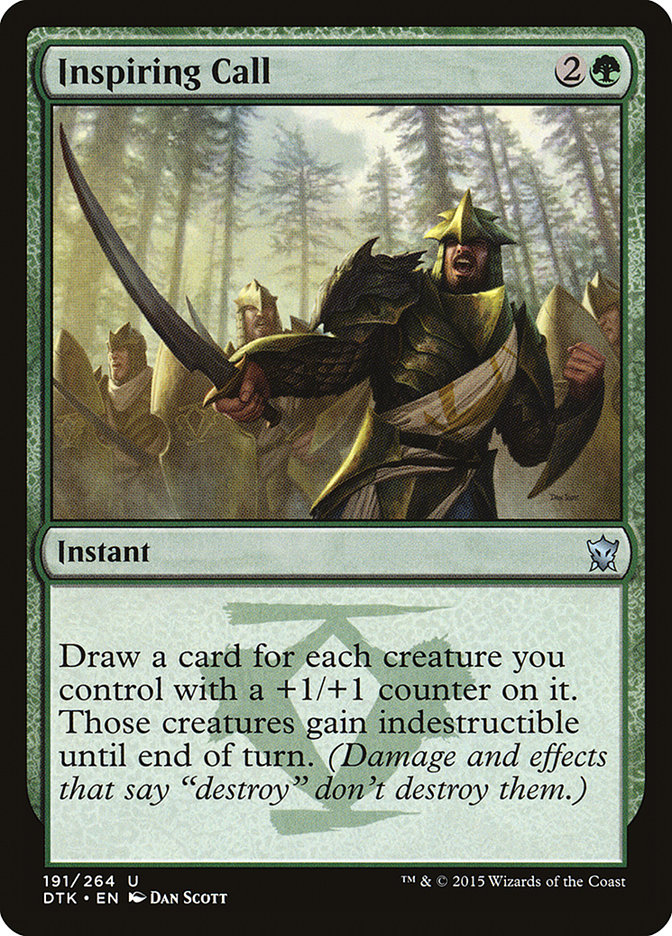
This is a much more controversial reason to play +1/+1 counters, and while I agree completely that it will end up the centerpiece of a lot of bad decks, I actually think this card has better chances than people are giving it credit for. Obviously this deck is going all-in, trying to draw several cards each time. However, even if you just save a creature from a removal spell and draw a card, you are at least doing something. Maybe it ends up not being good enough, but I wouldn’t be so hasty on this one.
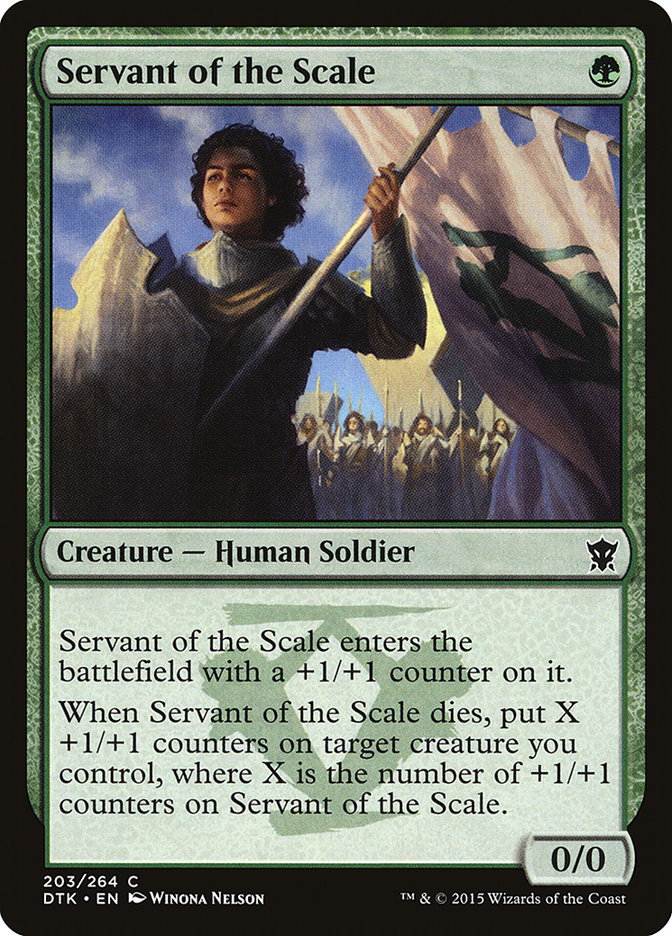
A better enabler than it might appear on the surface, Servant of the Scale gives you 2/2’s worth of stats for one mana without even trying, albeit slowly. If you have ways to take advantage of the counters or get more, you can get a great deal on your mana.
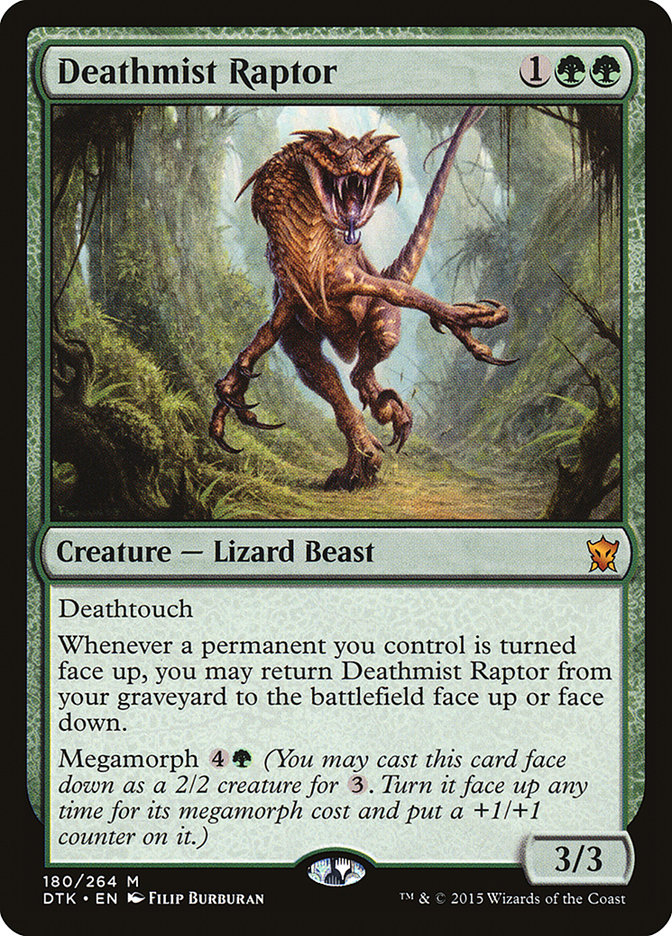
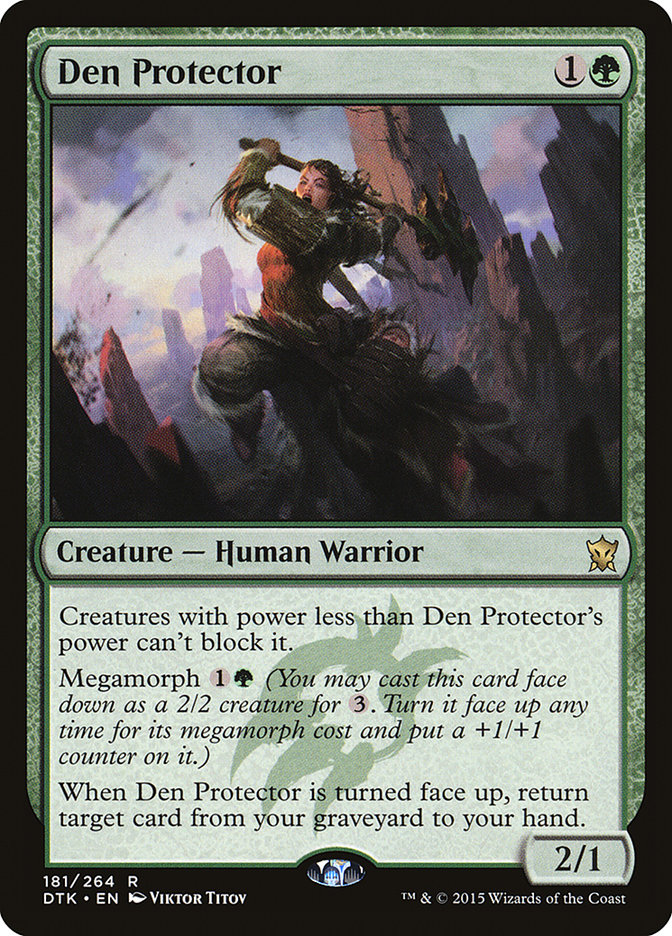
I kind of imagine that most people are going to fight us by sideboarding in a ton of removal. Maybe we can grind them out with this dynamic duo. Their megamorph abilities even mean they will have positive synergies with our counter-counting cards.
While I generally prefer Deathmist Raptor in maindecks, it is a pretty sweet way to add a dimension to a deck after sideboard, particularly if you can sideboard more morphs. Post sideboard games are often grindier anyway, since a bunch of the good sideboard cards are efficient removal spells and nobody really has dead cards or unanswerable ones.
The one Nykthos, Shrine to Nyx is probably worth the minor risk of not casting Avatar on two since it can give us some pretty hot Hydras from time to time. Of course, I kind of just want to play into the Nykthos a lot more, and actually play a more traditional devotion strategy. For instance:
Creatures (33)
- 4 Elvish Mystic
- 4 Polukranos, World Eater
- 1 Nylea, God of the Hunt
- 4 Sylvan Caryatid
- 4 Voyaging Satyr
- 4 Courser of Kruphix
- 2 Genesis Hydra
- 4 Whisperwood Elemental
- 3 Shaman of Forgotten Ways
- 3 Dragonlord Atarka
Planeswalkers (2)
Lands (12)
Spells (13)
- 10 Forest
- 1 Mountain
- 2 Crater's Claws

The one Devotion strategy that has always shown up, at least to some degree, a variety of green devotion decks have returned to the top tier with the printing of Whisperwood Elemental. The Elemental’s raw power is quite high, it fits into the green game plan perfectly, and it gives the strategy extra resilience against its biggest baseline weakness, sweepers.
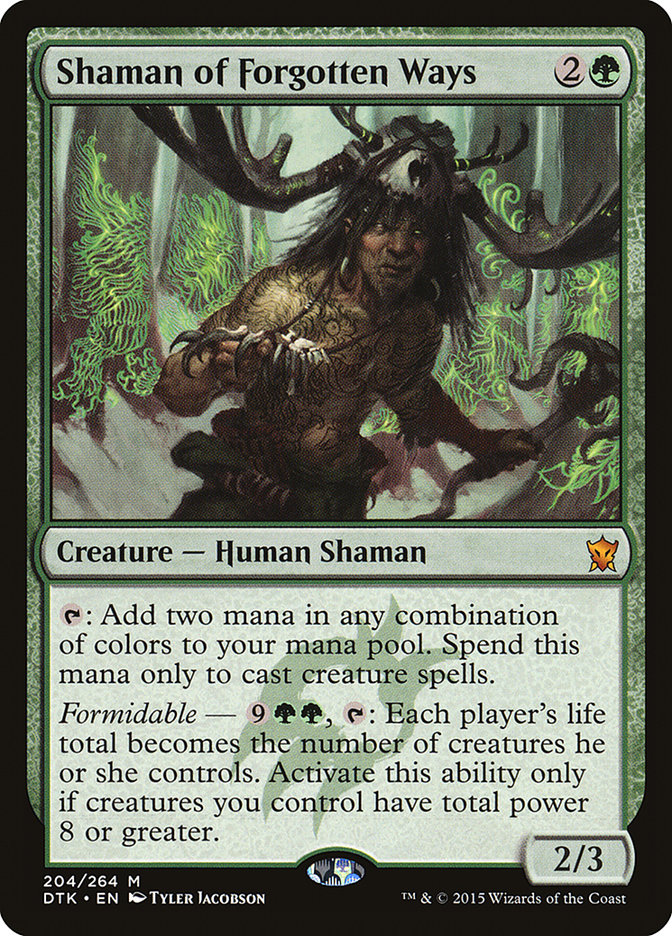
Green devotion decks have a variety of new tools to work with, depending on whether they want to be big mana, aggro, planeswalker-based, built around manifest/morph, or chasing some other theme like +1/+1 counters or Dragons. Shaman of Forgotten Ways is one of the most interesting new additions to the big-mana approach. It loudly tells you to avoid Nissa and Ugin, but in exchange for that sacrifice, you get a double accelerator at a spot on the curve you could actually afford to make room for. It helps make splashing a color much easier, particularly if you want to splash big Dragons.
Additionally, the Formidable ability gives us a few dimensions we didn’t have before. Against opponents with few creatures, it can be an extremely large burn spell that makes basically any attack lethal (or even just kills them outright). As a note, remember you can do this at instant speed, which is going to win more than a few games against opponents that don’t realize you are about to burn them for sixteen and then untap. This also gives us a way to break stalemates, particularly those caused by Mastery of the Unseen or Whip of Erebos leading to opponents with a hundred or more life.
The only weird part about the Shaman is that it can’t use its own mana to pay for its formidable ability, which can be surprising. Nevertheless, it basically ramps us straight into Whisperwood Elemental or reasonable-sized Genesis Hydras. Hell, if we have a turn-two Voyaging Satyr and a turn-three Shaman of Forgotten Ways, we’re one mana away from a turn-four Dragonlord Atarka!
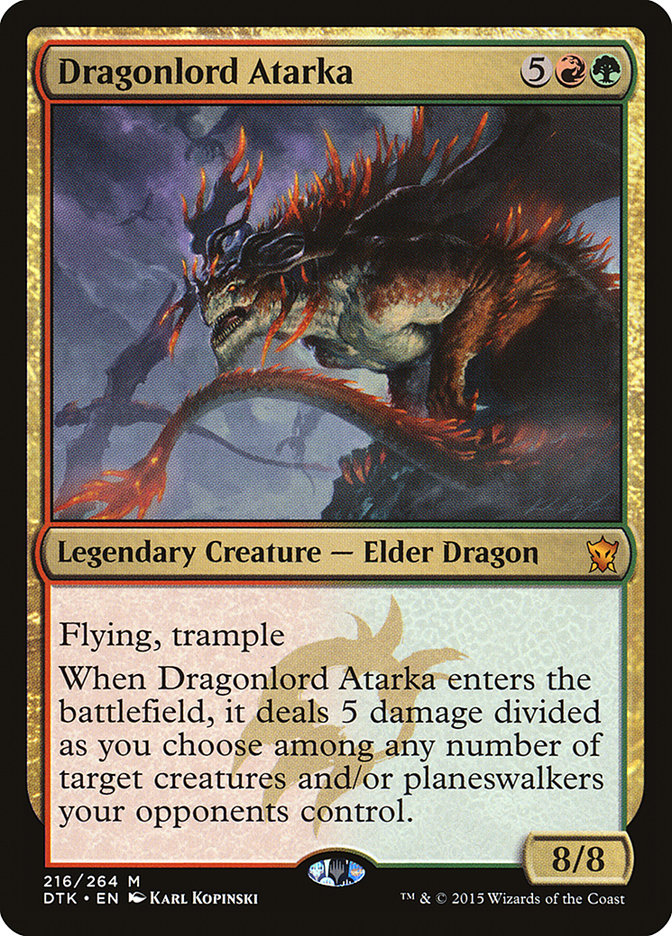
A lot of people have dismissed this card because of its casting cost, but I’ll tell you who hasn’t:

Disagreeing with the Dragonmaster on a Dragon being good is like disagreeing with the Rainmaker, Patrick Sullivan, on whether a cheap aggressive red card being playable or not.
In all seriousness, Dragonlord Atarka is pretty good, even at seven mana. Let’s take a look at another Dragon that saw a lot of competitive play despite actually costing eight mana.
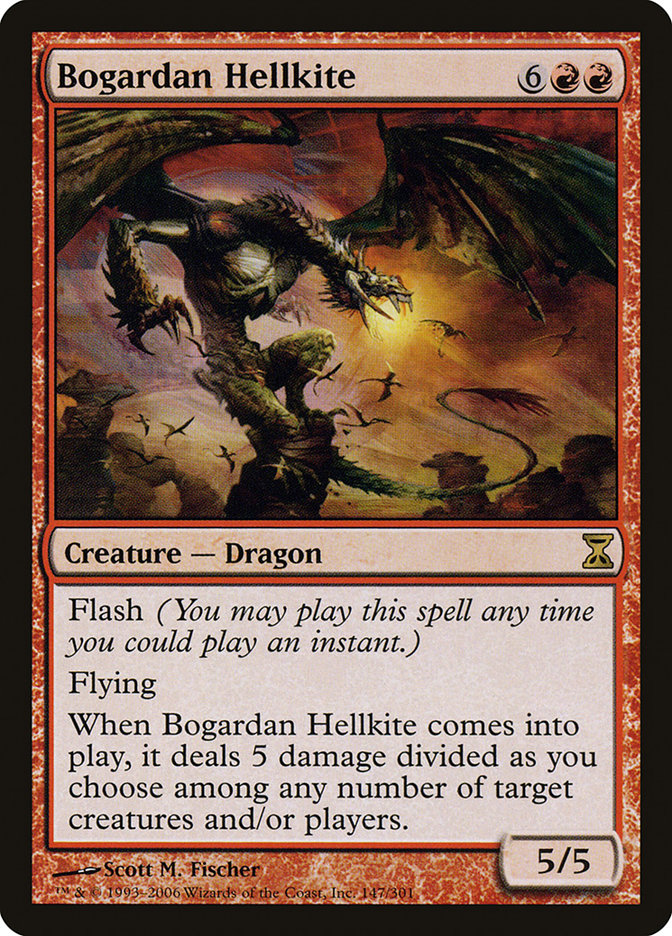
Yes, Bogardan Hellkite was much more popular because of Dragonstorm… however, that was not the only way people used the card, it was often just cast straight-up. Now compare it to Dragonlord Atarka. While the Hellkite has flash, costing a mana less is generally better. Atarka has a more restrictive cost, but not by much, and is a legend, both of which are factors. However, she’s also +3/+3!
That is a big upgrade. Dragonlord Atarka is quite a bit better than Bogardan Hellkite, if you ask me, and seven drops are totally playable. People already play Garruk and Ugin, and there’s not exactly a shortage of good accelerators. Dragonlord Atarka has a major impact on the board, so even if opponents play a removal spell, you typically got a lot accomplished, and if they ever don’t? Dey gun’ die!
Ever play Hornet Queen in a deck that was planning on casting it? It’s really not that hard, nor uncommon. Of course, maybe Atarka’s not the only Dragon we should be packing…
Creatures (28)
- 4 Elvish Mystic
- 4 Stormbreath Dragon
- 2 Fanatic of Xenagos
- 4 Goblin Rabblemaster
- 4 Rattleclaw Mystic
- 2 Dragonlord Atarka
- 4 Scaleguard Sentinels
- 4 Thunderbreak Regent
Planeswalkers (2)
Lands (13)
Spells (17)

See, this is where we gotta get Kibler on the line. There is so much awesome stuff smack-dab in the middle of his wheelhouse, I’ll take one-to-one odds that he makes another Pro Tour Top Eight by next spring. Just you watch.
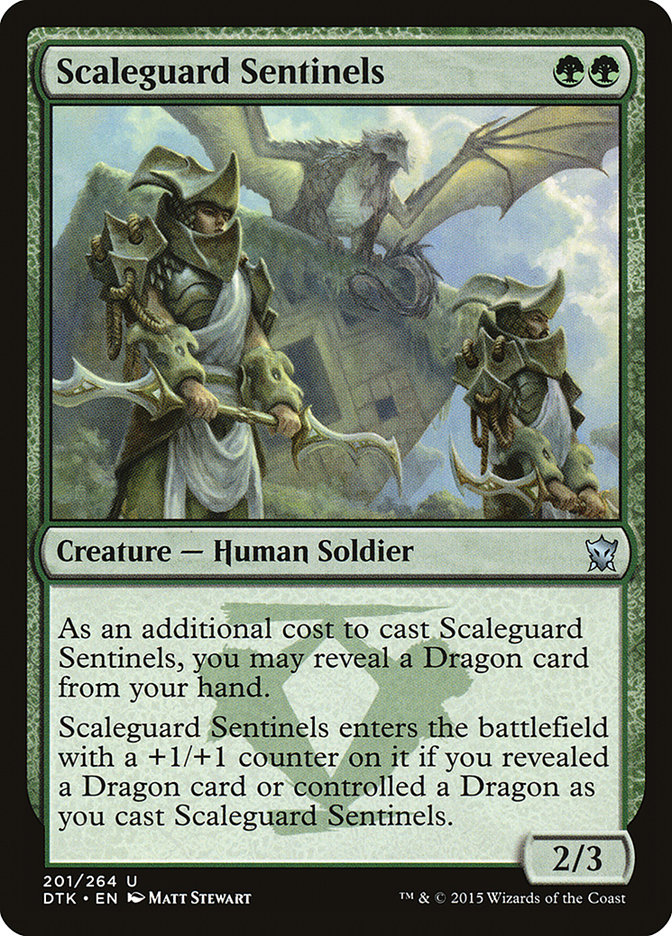
Scaleguard Sentinels might not be the flashiest payoff ever, but it’s going to be a 3/4 for two 80% of the time. And it’s not like the fail states are even that bad. You still get a 2/3 for two, which is not abysmal. Now, maybe it’s not realistic to play nine or ten Dragons, however, once you have them you are absolutely going to be at least interested in a creature that is a 3/4 for two 80% of the time and still a 2/3 for two the other 20% of the time.
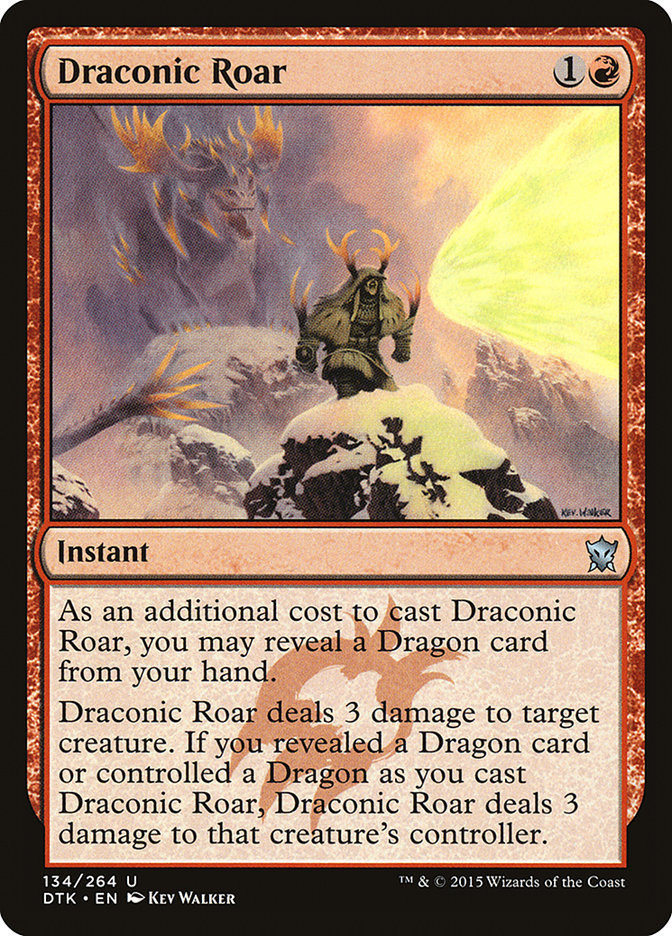
Unlike Scaleguard Sentinels, which really needs you to have the Dragon ASAP, Draconic Roar can be held for a number of turns, giving you more chances of finding a Dragon to “kicker” it. Even if you don’t have one, though, you are still usually just using it to kill a creature the same way Lightning Strike would have. Getting to kick it is a real nice bonus, however, as the extra three damage to the face at the same time you kill a creature is well worth the games you want to go to the face, but can’t yet because you don’t have a Dragon.
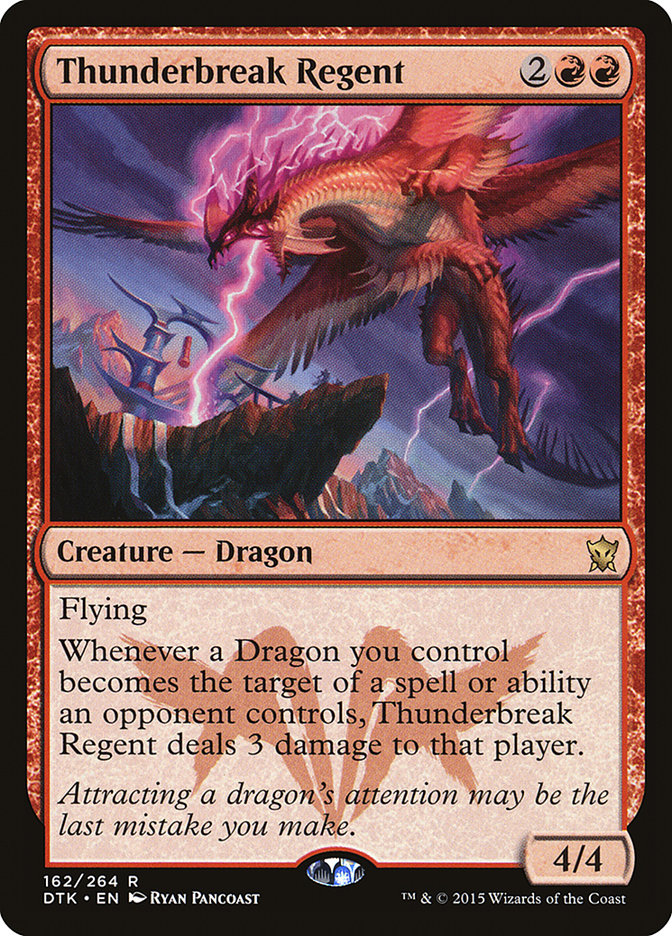
A quality Dragon that costs less than the rest, which generally makes red a part of most dedicated Dragon strategies. The Thunderbreak Regent isn’t just a 4/4 flier for four that powers up your Dragon-kicker cards. Its “protective” ability is great for making life a bit harder for removal-heavy opponents, specifically black decks. They may want to Hero’s Downfall your Stormbreath Dragon on five, but if you play a Regent on four, their life is a lot worse off.

I wanted to play the Phoenix rather than the Fanatic of Xenagos, but I was concerned about a turn-two Safeguard Sentinel making it hard to play the Phoenix on three. Maybe I am being overly cautious. Maybe I should just suck it up and play more Mana Confluences and Rugged Highlands. I’d rather see if we can make it worth it with awesome mana, first, though.
I had also considered Deathmist Raptor, since we already have Rattleclaw Mystic and it’s not like we’re that far off. If we can make room for some Ire Shamans, maybe an Ashcloud Phoenix, we’re there. Of course, we could also just build around that theme rather than the Dragons.
Creatures (30)
- 4 Elvish Mystic
- 1 Stormbreath Dragon
- 1 Boon Satyr
- 4 Goblin Rabblemaster
- 4 Rattleclaw Mystic
- 4 Ashcloud Phoenix
- 2 Whisperwood Elemental
- 2 Shaman of the Great Hunt
- 4 Deathmist Raptor
- 4 Ire Shaman
Planeswalkers (1)
Lands (10)
Spells (19)

This list has obviously prioritized flip-triggers for Deathmist Raptor, but it’s not like any of these cards are weak on their own.

This card is great! A 3/3 with deathtouch for three isn’t that far off, and if you ever bring it back you’re way ahead. That it also has Megamorph is just random extra upside. It makes it hard for people to figure out what to kill with their removal and what to block, plus it lets us dodge Abzan Charm’s attempts to exile our Raptor. It even gives us something else to do with our mana when we are flooded, and an extra +1/+1 is appreciated here, as it gives us another source of Ferocity.
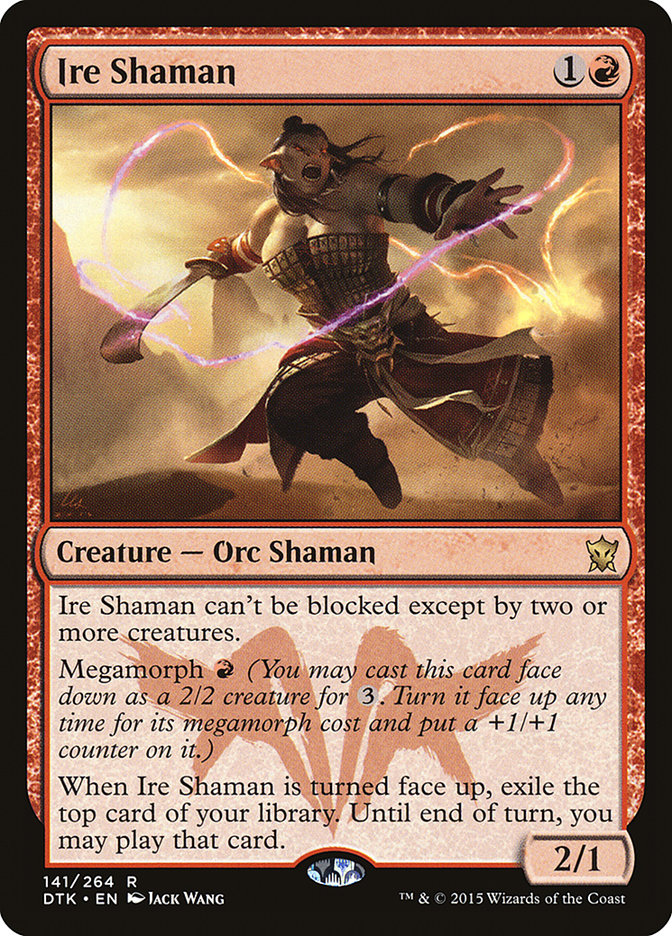
I’m a fan of Ire Shaman. To start with, it is not an embarrassing turn-two play. It only hits for two damage, sure, but it’s also hard to block, so it will get a lot of damage in where other creatures would have gotten bricked by a Courser. It actually plays into the flying theme reasonably well.
However, we actually would prefer to morph the Ire Shaman, since it lets us buy an extra card for one mana next turn. We effectively spent two extra mana on the card, since the morph cost only one more than the Shaman normally would have, however, we are also getting a +1/+1 counter out of the deal – and a 3/2 with evasion is a serious threat. Obviously opponents would love to target the Ire Shaman with removal before you get a chance to use the ability, however, if they guess wrong and kill your Raptor, you get to use cards like Ire Shaman to bring it back for free.
This is another deck where I’d like to use Flamewake Phoenix maineck but am a bit concerned about the mana. However, without a GG two-drop, I think it’d be a much more reasonable move here, particularly if we added a Mana Confluence or two.
Another possible direction to go with Deathmist Raptor is in a dedicated all-in morph deck:
Creatures (24)
- 4 Elvish Mystic
- 4 Rattleclaw Mystic
- 3 Icefeather Aven
- 3 Sagu Mauler
- 4 Stratus Dancer
- 4 Deathmist Raptor
- 2 Ainok Survivalist
Lands (12)
Spells (24)

This list is trying to see how far you can push the face-down mechanic. My guess is that this list goes too far. I would be surprised if you can just get away with playing zero removal, without doing something very big very fast.
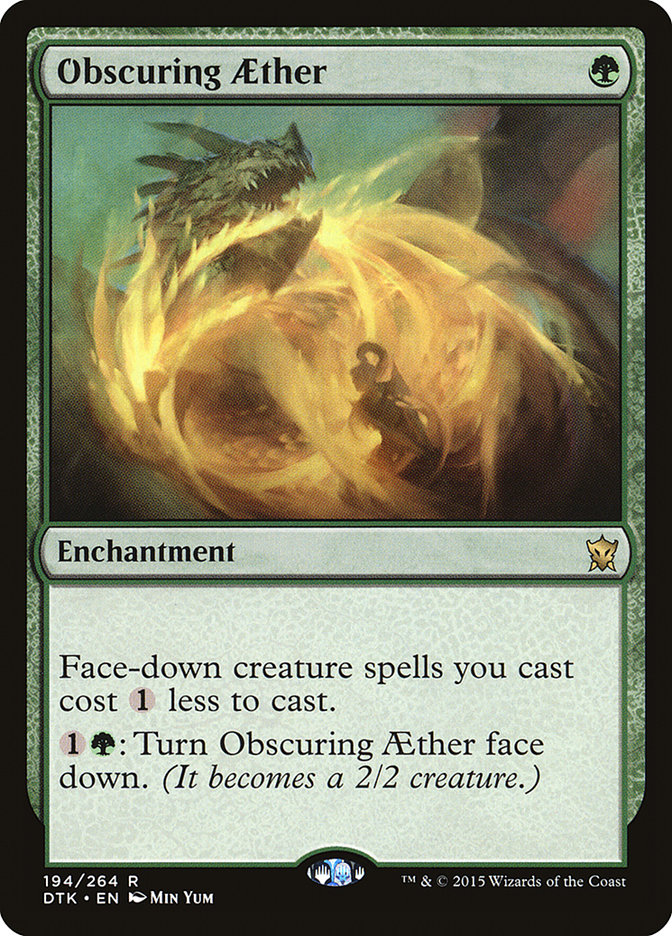
If we’re serious about going all-in, Obscuring Aether is vital. It curves perfectly, letting us start playing our morphs on turn two. Later on, we can cash it in for another 2/2, which is particularly nice against removal-based strategies.
Step-by-step instructions on how to Magical Christmasland:
Step 1: Forest, Obscuring Aether
Step 2: Yavimaya Coast, Obscuring Aether, Obscuring Aether, Morph, Morph, Morph.
Step 3: Secret Plans, smile evilly
Seriously though, we don’t actually need to draw three Obscuring Aethers to be doing it. As long as our opponent’s don’t play a Goblin Rabblemaster, we can do some pretty sweet things with just one copy.
The other face-down rewards aren’t too shabby either. The extra toughness on Secret Plans is actually pretty sweet, but it’s really about drawing a bunch of cards for very little cost. Trail of Mystery has a less impressive form of card advantage attached to it, but the threat of +2/+2 is going to make combat a nightmare against us.
Ghostfire Blade isn’t really doing anything novel, but a one-cost equipment that only costs one to move is definitely above the expected rate and will give us a bigger, stronger board earlier than you’d think possible. Sometimes we are just going to be on the “tie up the ground, win in the air” plan, and Ghostfire Blade helps on both offense and defense when we are going that route.
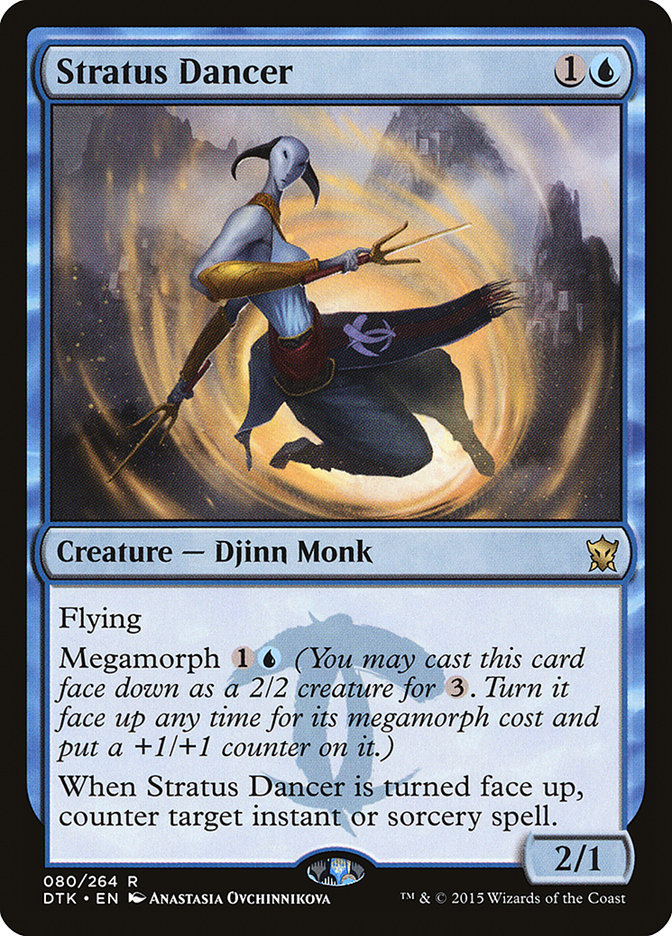
Stratus Dancer is one of the better cards in Dragons of Tarkir, provided you can find a home for it. The threat of any of your morphs potentially giving you a Negate without it costing you a card makes it much harder for people to play against you. You’re even left with a 3/2 flier, which is a serious threat. Besides, it’s not like a 2/1 flier for two is that bad of a fall-back plan.
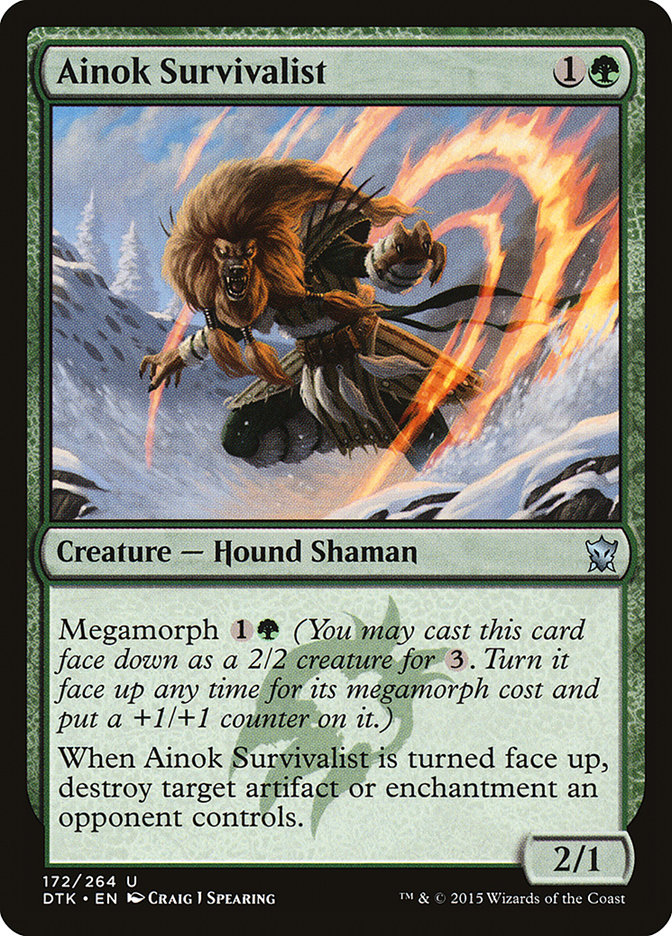
A respectable card, and once we have all these face-down rewards our bar goes down, but I’m not sure we’re midrange-y enough to appreciate the Naturalize effect. Let’s not kid ourselves. We’re not “taking control” of games. For better or worse, we are racing. The fact that Ainok Survivalist kills Courser of Kruhpix and Mastery of the Unseen is the one saving grace that makes me give it a pass.

I might just be crazy to not play the Den Protector, but we have so many other options, and a five-mana Regrowth sounds way better to me in a midrange deck with potent spells worth recursing.
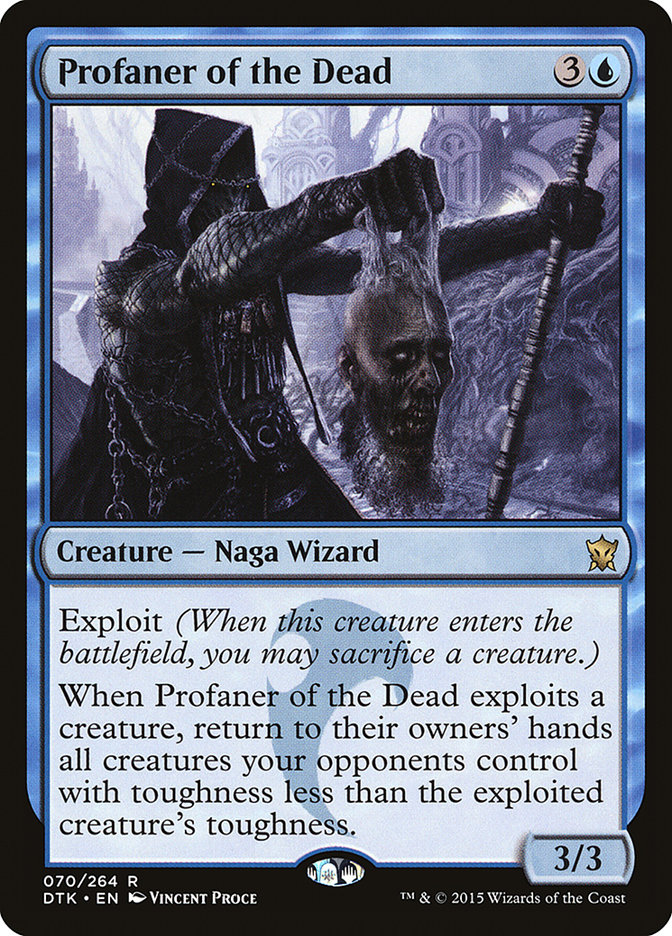
This gives us a much_needed way to break through stand-offs. It’s also a fine anti-token card, since the tokens aren’t coming back. Remember, you can sacrifice the Profaner to itself, which gives us a respectable-sized bounce effect. However, you can also sacrifice a Deathmist Raptor wearing a Ghostfire Blade if you need to bounce larger things. You’re going to be able to get it back later, anyway…
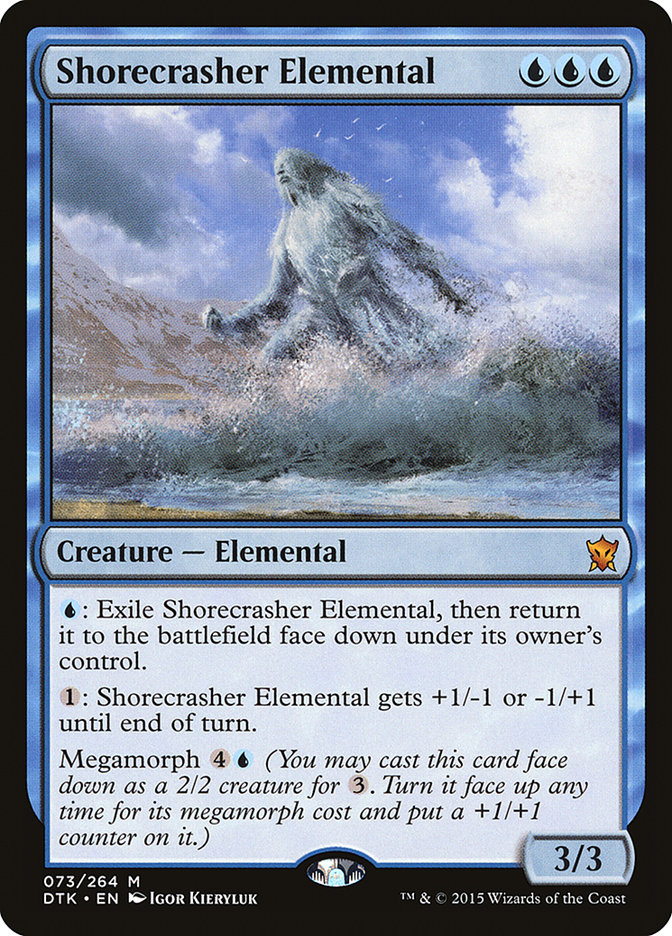
As crazy as it sounds, I considered Shorecrasher Elemental here. Maybe there’s a way to make the mana work, since we can still play the Shorecrasher for three in games we don’t draw triple blue. We’ve got so many good options, however, I didn’t want to tempt fate.
The Shorecrasher’s primary purpose, of course, is to reignite Mono-Blue Devotion. It’s got a good rate if you’ve got blue mana like nobody’s business, which Blue Devotion decks major in. That it is so good against removal helps take Blue Devotion down a much more resilient path than previous versions. The morph ability works well with Stratus Dancer and Gudul Lurker (if you want it), helping obfuscate which threat you are playing when. It’s even an Elemental, so Master of Waves makes it hit harder!
Creatures (24)
- 4 Master of Waves
- 2 Jeskai Sage
- 4 Stratus Dancer
- 4 Shorecrasher Elemental
- 4 Palace Familiar
- 4 Silumgar Sorcerer
- 2 Icefall Regent
Lands (12)
Spells (24)
Sideboard

This is a very different approach to Blue Devotion, as the format seems very hostile to decks without any removal. Maybe we still want Gudul Lurker, but I found the one-drops to be too low-impact. Besides, we don’t have Frostburn Weird and Tidebinder Mage to play D for us anymore. It’s also hard to actually wake Thassa up without our double-blue two-drops.
Instead, I am pushing more towards Bident of Thassa. We don’t have to be hitting with very many creature for Bident to start reaping us a sizeable advantage, particularly when we have actual removal like Wild Slash and Lightning Strike to convert card advantage into board presence.
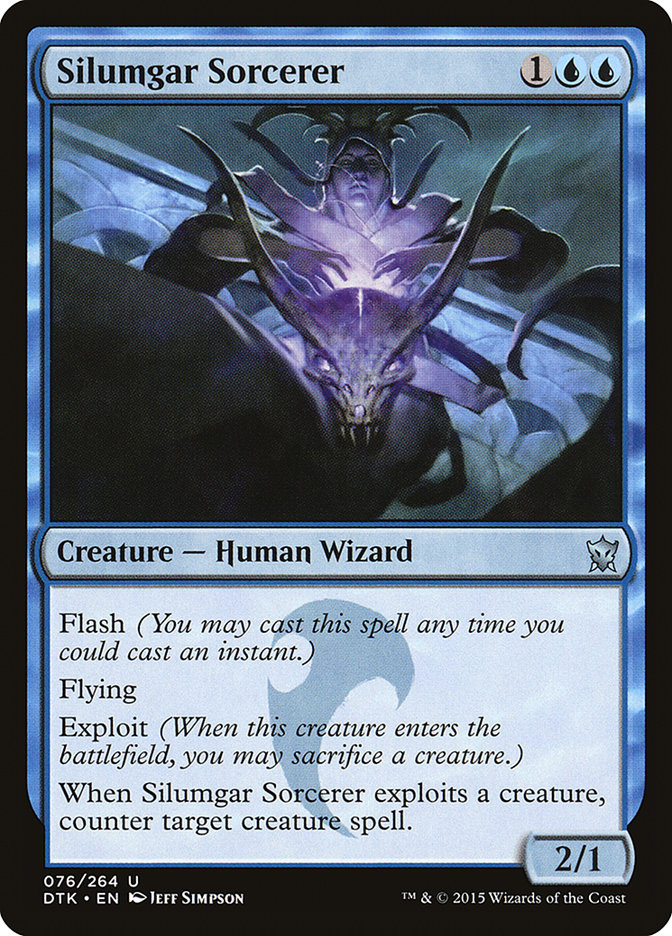
Silumgar Sorcerer is a deceptive creature that often actually plays like a spell, but I actually think it’s pretty sweet. Think of it like a Charm with three modes:
- You can pay 1UU for an Essence Scatter, sacrificing the Sorcerer to itself. This may not sound amazing, but having the option to Cancel a Siege Rhino is a big deal. Usually, the problem with creature-specific counters is how weak they are against opponents with few creatures or those already ahead on board. However, Silumgar Sorcerer has two more modes!
- You can pay 1UU for a 2/1 flying flash creature. This is a great way to surprise people with an extra attacker (hopefully drawing a card with Bident), and can even wake up Thassa by surprise! Remember, you can exploit a creature, even if there is no creature spell on the stack. This means you can use the Sorcerer to fizzle an opposing Bile Blight pointed at one of your two Master of Waves.
- You can get the same Essence Scatter option from above, but upgrade a Palace Familiar or Jeskai Sage into a 2/1 flier. You even get to draw a card!
So, what’s the catch? Sadly, if we are trying to counter a Stormbreath Dragon, a single Wild Slash can ruin our fun. Our opponent can respond to the exploit trigger by killing the creature with exploit, which makes its ability not fire. We don’t have to sacrifice a creature for nothing, but we also don’t get the Counterspell we were counting on.
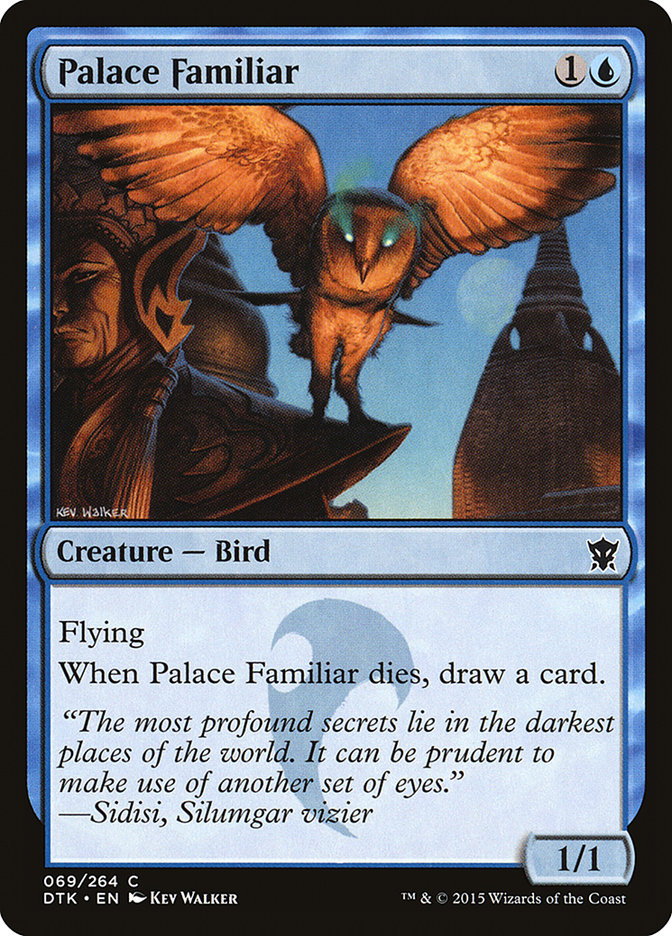
While I was originally drawn to two-power fliers, I just don’t think we can realistically race people. Besides, everyone has a lot of cheap removal. This is where Palace Familiar comes in. Now we can actually get ahead when they kill our creatures, and if they don’t, then we Bident them!
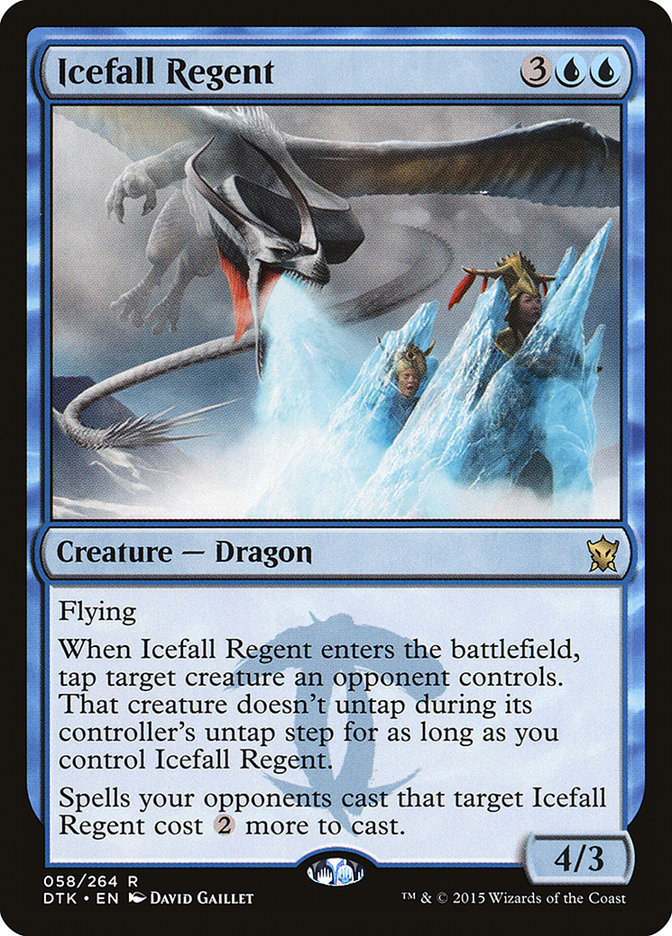
Icefall Regent is definitely a bit higher on the curve than previous builds would have tried, but this approach to Blue Devotion has a lot more ability to play fair and interact with opponents. Icefall Regent actually plays right into this, letting us lock down an opposing Stormbreath Dragon. Often opponents will hope up exactly three mana for a Hero’s Downfall on whatever threat we play, and Icefall Regent will really slow them down then. Not only do they not get to play their removal spell on our turn, they have to spend five on the following turn.
Of course, once we back so far away from Thassa, one starts to wonder if we’re even getting paid enough to justify supporting Master of the Waves.
Creatures (26)
- 3 Stormbreath Dragon
- 4 Flamewake Phoenix
- 4 Stratus Dancer
- 4 Thunderbreak Regent
- 4 Palace Familiar
- 4 Silumgar Sorcerer
- 3 Icefall Regent
Lands (12)
Spells (22)
Sideboard

Even if we don’t maindeck them, I think we want access to Master of Waves. Red decks are going to be popular early in the format and ze Master is just amazing against them. Besides, we don’t exactly have a trivial amount of devotion to support it with.
Silumgar’s Scorn and Draconic Roar are perfect for playing an aggro-control game and can help us press an advantage from our aggressive fliers.
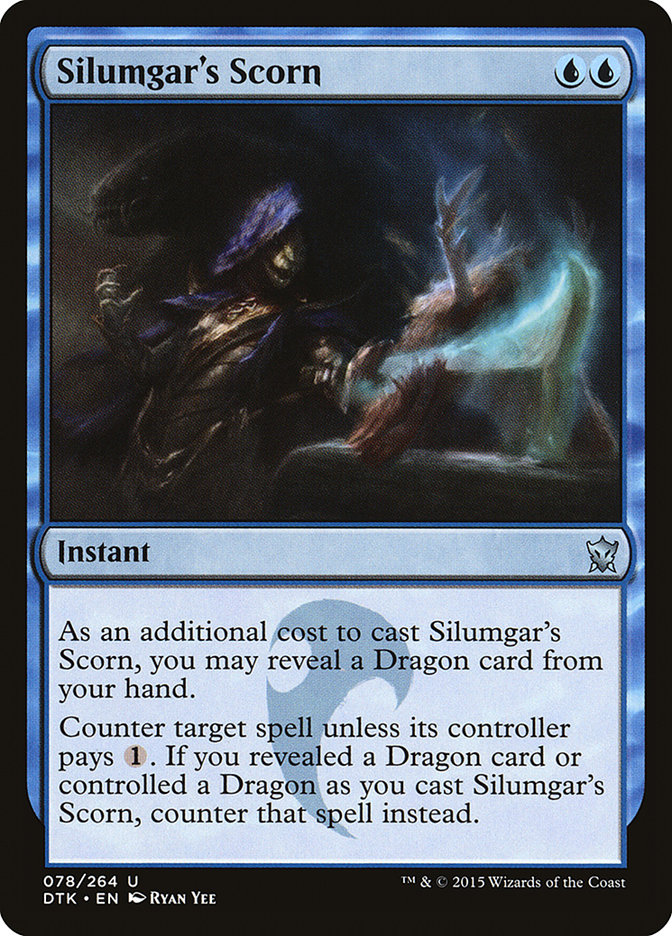
Playing ten Dragons is unusual, no question, but so is getting to play Counterspell. Even if we only end up playing six or eight Dragons, Silumgar’s Scorn is serviceable as a Force Spike as a “back-up plan.”

Flamewake Phoenix works with tons of creatures in the deck, is a great threat with Bident, and is ideal food for Silumgar Sorcerer.
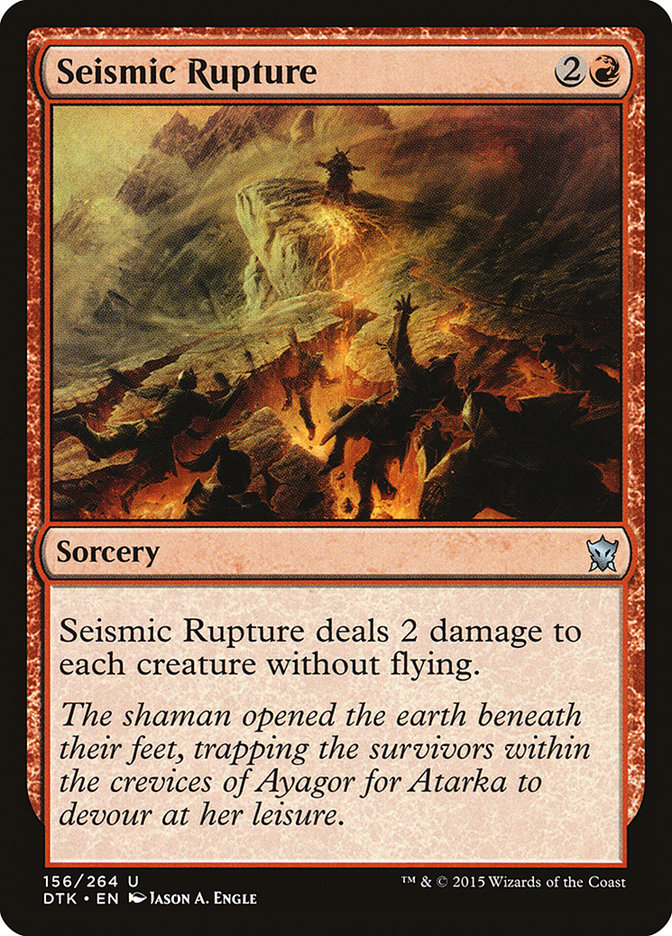
Its special ability, compared to Anger of the Gods, is that it doesn’t kill any of your creatures instead of most of them!
I really think the Dragon-rewards cards are one of the richest areas of exploration, as they all look pretty solid. There are a lot of potential Dragon-based strategies, some more committed than others. The whole cycle looks playable:
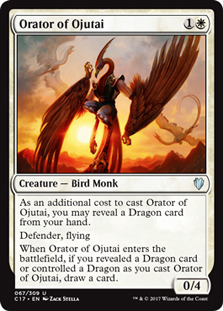
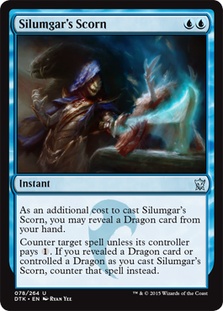
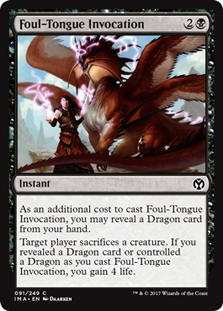
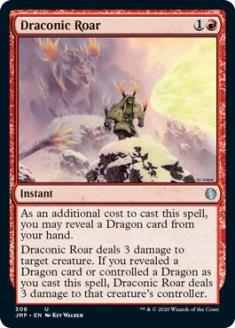
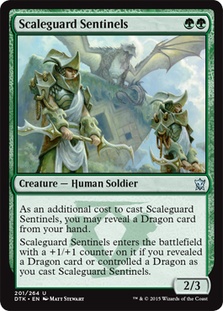
For instance, here’s a possible style that uses the Dragon-kicker cards we haven’t discussed yet, today:
Creatures (16)
Lands (22)
Spells (22)

Just about any strategy can be shifted into a Dragon deck, with the right massaging. This one is a midrange Mardu deck that has Dragons instead of Butcher of the Horde and Wingmate Roc. Of course, it also gets better removal and a flying Wall of Omens!
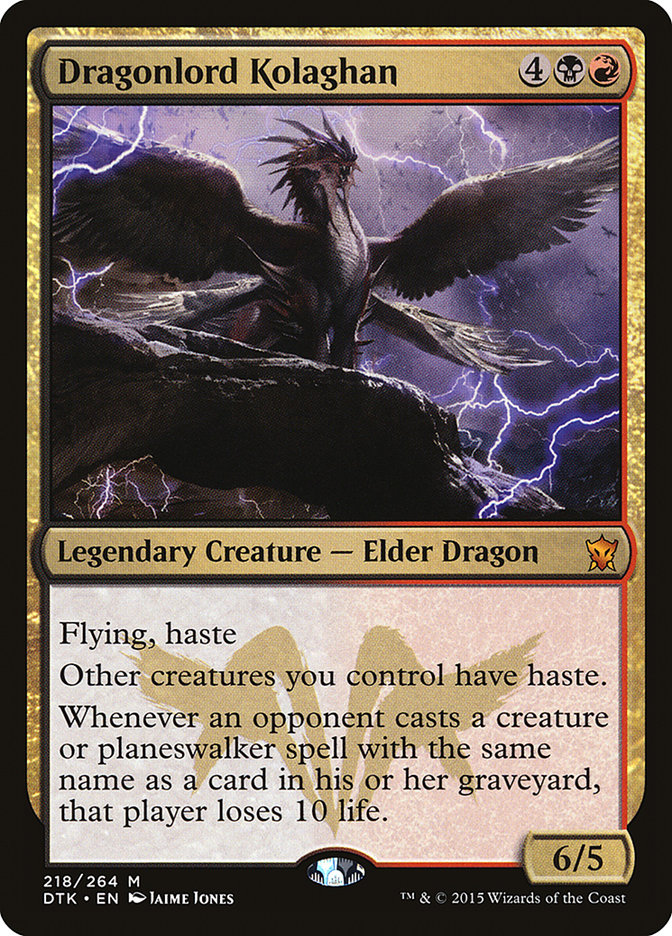
While I think all five of the Dragonlords are playable, Dragonlord Kolaghan is a bit underrated compared to some of the others, most notably Dragonlord Dromoka and Dragonlord Ojutai which are slightly overrated (though still good).
Dragonlord Silumgar is as good as the hype, by the way, but that’s another story…
As for Kolaghan, she’s an easier to cast Rorix, Bladewing that also gives your whole team haste. This is particularly sweet when Dragonlord Atarka is your follow up next turn. It’s also nice if you’re ever playing a Sarkhan Unbroken deck that ultimates both of those two into play at the same time.
Kolaghan’s ten damage ability is also quite nice. It doesn’t interact with cards like Hero’s Downfall, but it does disrupt opponents trying to stay alive with Siege Rhino. Even more dramatically, it can really shut down Elspeth. Kolaghan is already naturally well-suited to killing Elspeth in one shot – then our opponents can’t even use a second Elspeth to kill Kolaghan without getting blasted for ten!
While Mardu is still totally an option, there is more reason than before to stick to two colors. It’s not just a larger card pool giving us enough quality cards to not need to dip into a third color. A number of the powerful new cards have double-colored mana symbols. Do we need a third color? Here’s an attempt to do the midrange thing without black, for a change:
Creatures (9)
Planeswalkers (7)
Lands (16)
Spells (28)

This is a lot more card advantage than W/R normally has access to.
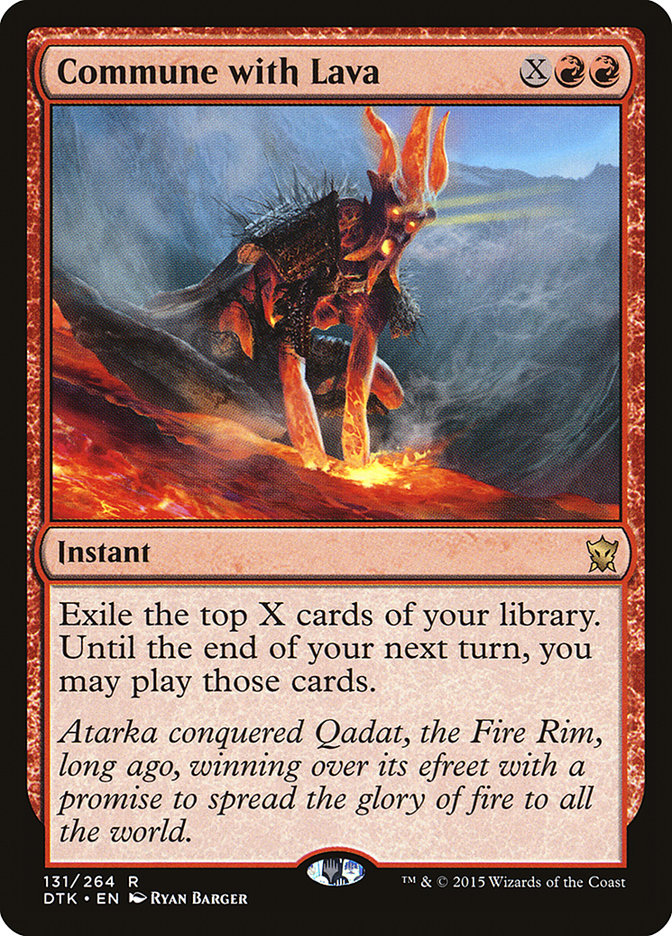
Commune with Lava can be a bit unwieldy, but we are very in the market for card draw in a deck like this, and even just doing it for three on our opponent’s end step can be a big deal. Besides, in a pinch, we can just do it for one, or even zero to save our Ojutai Exemplars.
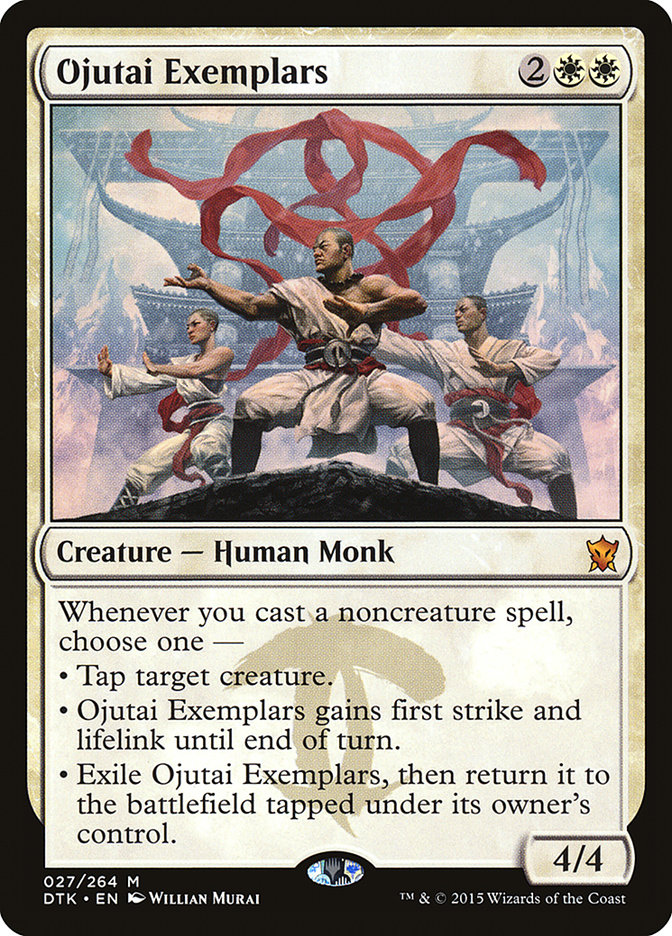
I love this card! Its power level is respectable and it gives us a lot of options that we’re actually in the market for, particularly when attached to a 4/4 for four (which means we didn’t pay much for them).
The most important ability on the Exemplars is the “blink” mode, which lets us fight spot removal. Of course, the lifelink + first strike mode is absolutely great for turning around games that we would otherwise lose.
The tap ability is the least important, but has tactical implications, such as tapping a Sidisi, Undead Vizier that is in the way.
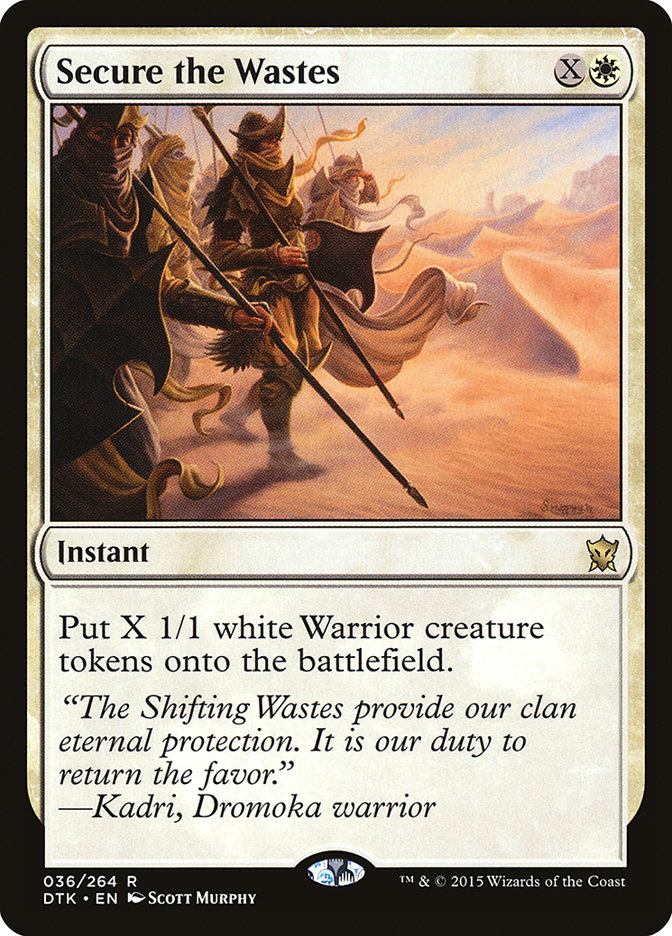
For just one mana more than Raise the Alarm, you get a lot of options. I am generally a fan of this card. It’s not insanely powerful or anything, and it gets hit by cards like Bile Blight, but it’s going to be better than people expect because of just how often you end up in drawn-out battles where both players flood our and are battling in an attrition war.
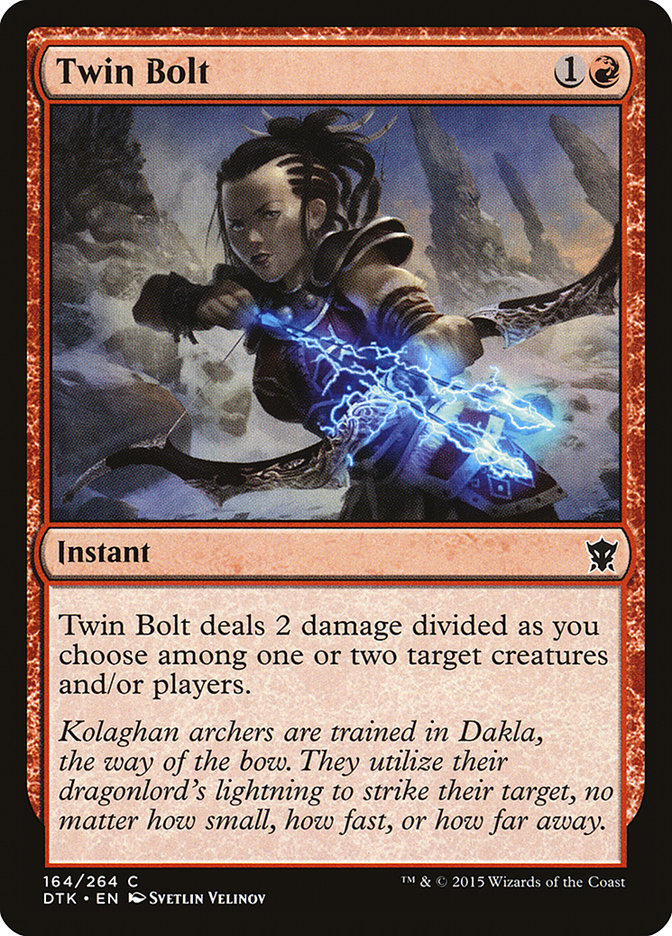
I like Twin Bolt a little more than Arc Lightning, but it also depends on your curve. There are so many good three-mana plays in the format that I generally prefer having a two-mana option. Besides, that it is an instant is particularly nice for fighting Raise the Alarm.
Of course, I still prefer the card draw available to black for decks like this. We discussed B/W Midrange on Monday, but what about B/R Midrange?
Creatures (6)
Planeswalkers (1)
Lands (20)
Spells (33)

Now we’re starting to get into some serious black control space. What’s making it possible?
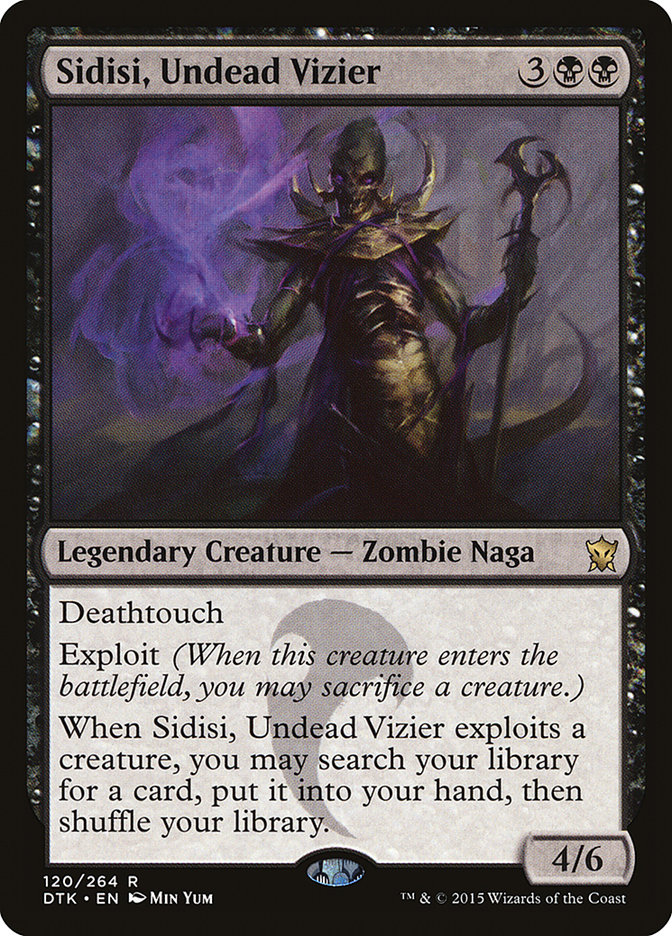
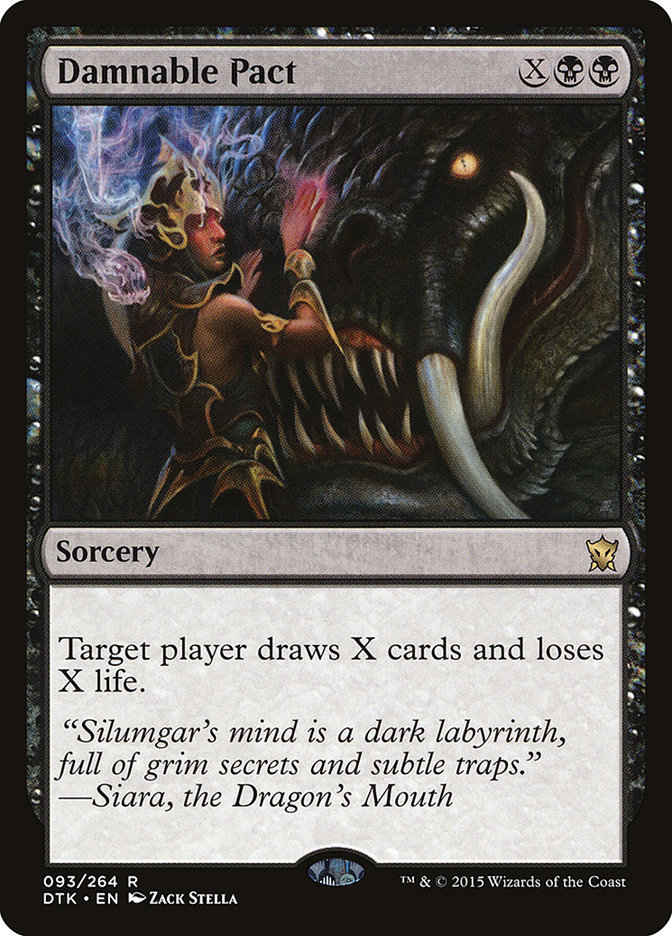

Sidisi is a very powerful new addition to the format that really changes the balance of power, as well as strongly encouraging different deckbuilding choices than previously.
Monday’s article has an in-depth breakdown of why Sidisi is so good, but suffice it to say the body is huge, you don’t need to buy the Diabolic Tutor, and if you do get it you are generally getting a really good deal. In a pinch, you can even sacrifice Sidisi to herself. The one thing to be careful of, if your opponent kills her in response to the trigger, you get nothing. Thoughtseize can be particularly nice for making sure you know if the coast is clear. Of course, Duress works, too.
Having access to Thoughtseize and Duress means that black decks can now put a serious hurt on control decks if they are so inclined. Back it up with Read the Bones and Damnable Pacts, maybe other card advantage engines like Outpost Siege, Palace Siege, and Liliana, and you’re talking about a serious game-plan.

I keep building decks to use this card, but then end up cutting most of them. Maybe it’s just great, but we’re always so glutted on options at three that it’s hard to really justify unless we have creatures that are dying early and often enough to count on it as a two-for-one against opponents that don’t have two-toughness creatures. That said, it is so cheap and versatile that it might just be worth it anyway.
Looking at this list, one can’t help but ask, “Why even play the red cards?”
Good question.
Creatures (18)
- 4 Gray Merchant of Asphodel
- 1 Erebos, God of the Dead
- 3 Bloodsoaked Champion
- 3 Sultai Emissary
- 3 Sidisi, Undead Vizier
- 4 Blood-Chin Fanatic
Lands (25)
Spells (17)

There is a definite price to pay for playing Mono-Black. One of the best reasons to play mono-color is Gray Merchant of Asphodel, but there’s a real shortage of good options for how to supply the rest of the devotion you want. I would be surprised if a bunch of creatures that can’t block are what a deck like this wants, but the interaction between Bloodsoaked Champion and Blood-Chin Fanatic is really, really powerful.
If you assemble the combo, all you need to do is attack with anything, even the Bloodsoaked Champion. Now you can sacrifice it to the Blood-Chin Fanatic to drain your opponent for two, then recast it. Repeat as many times as you have mana for, with every three mana you spend draining your opponent for another two, and we’re talking about some serious reach! That is also a really powerful way to recoup the life lost from Thoughtseize, Read the Bones, Damnable Pact, and the like. It’s also a very hard race for our opponents to win, particularly when we have so much discard to make sure it goes off without a hitch.
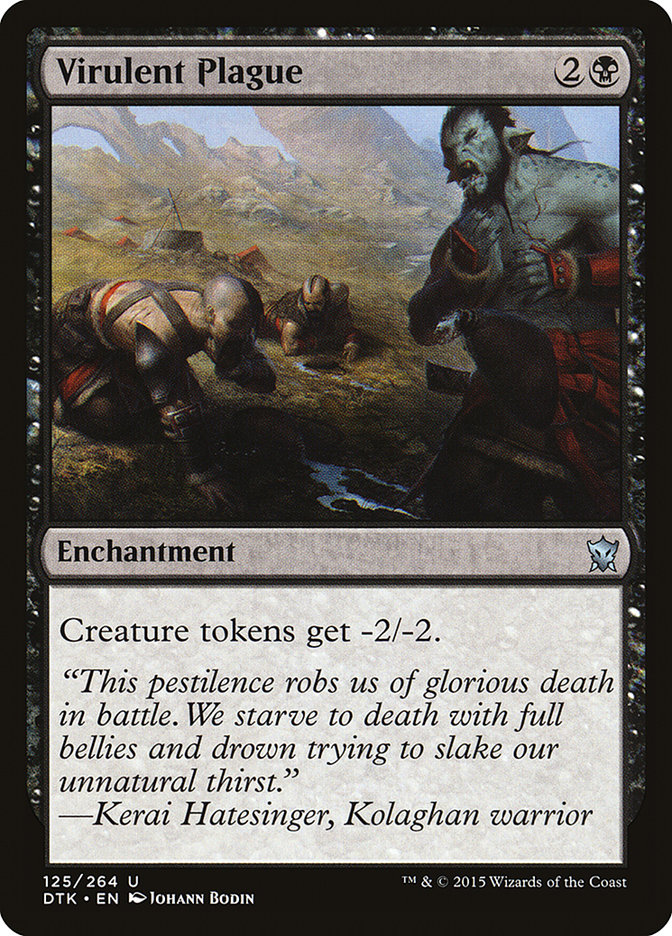
This card is amazing. If you’re building token decks, you better have this card in mind, because there’s going to be a lot of it.
Not every black synergy deck needs to involve devotion or Warriors, however. There’s an under-the-radar build-around in Dragons of Tarkir that 99% of people seem to think is just a cute gimmick.
Creatures (20)
Lands (18)
Spells (22)
Sideboard

Assault Formation is pushed to the extreme here, transforming our deck into a bunch of 4/4s for one and 5/5s for two that can get pumped at instant speed, sometimes twice a turn.

Two mana is not a ton of investment, but unlike Anthems that merely give +1/+1, Assault Formation will often give us +4 or +5 to each of our creatures. That it also pumps your team +1/+1 (effectively) for every three mana you spend is what makes me kind of curious about using it for real. Yes, the card is crazy good in the above list, but that list is going to struggle in games where it doesn’t draw the Formation…
However, what’s to say we can’t play Assault Formation in a more traditional deck? It pumps our Siege Rhino, double pumps our Courser, can make Sylvan Caryatid a 3/3 hexproof attacker and more. It’s a mana sink later in the game while also making our Elspeth tokens into extremely deadly threats. Alternatively, we can just use a Nykthos to get a ton of mana and go to town. Seriously, the ability to pay three mana to +1/+1 your team as many times as you like is a very powerful option.
Not even joking, I think Assault Formation might actually be the real deal, albeit in the more modest way just detailed. Just about the only thing standing in the way is the popularity of cards like Dromoka’s Command. That said, if we’re already playing Courser of Kruphix, maybe we just bite the bullet.
I also wanted to build an Abzan deck around this little card:

However, it’s hard to play these colors and not end up with a bunch of Thoughtseizes, Abzan Charms, and other removal. On top of that, Collected Company has to compete with Siege Rhino. You could play 6-8, and that’s somewhat interesting, but I’m curious about a deck that really means it. After all, when things are going well, Collected Company is a Bloodbraid Elf with flash, instead of haste. The catch of having to play relatively few non-creature spells is a big one, but not necessarily the end of the discussion. Here’s a possible take:
Creatures (28)
- 4 Boon Satyr
- 4 Goblin Rabblemaster
- 4 Rattleclaw Mystic
- 4 Heir of the Wilds
- 4 Savage Knuckleblade
- 4 Flamewake Phoenix
- 4 Frost Walker
Lands (18)
Spells (14)

The thinking here is that we can actually just play a ton of awesome twos and threes on their own merits, and then when we Collected Company, we’re going to typically get two powerful three-drops at the same time. With this configuration, we are roughly:
- 98.2% to reveal at least one hit off Collected Company
- 86.9% to reveal at least two
- 51.1% to reveal at least two 3-drops
Now, we don’t need to be anywhere near this all-in, but it is interesting to see how far we can take it. Even just playing about 22-24 hits is going to be passable, as long as at least a dozen are legitimately good hits.
Another possible linear theme I looked at with Dragons of Tarkir is that of a dedicated hexproof deck.
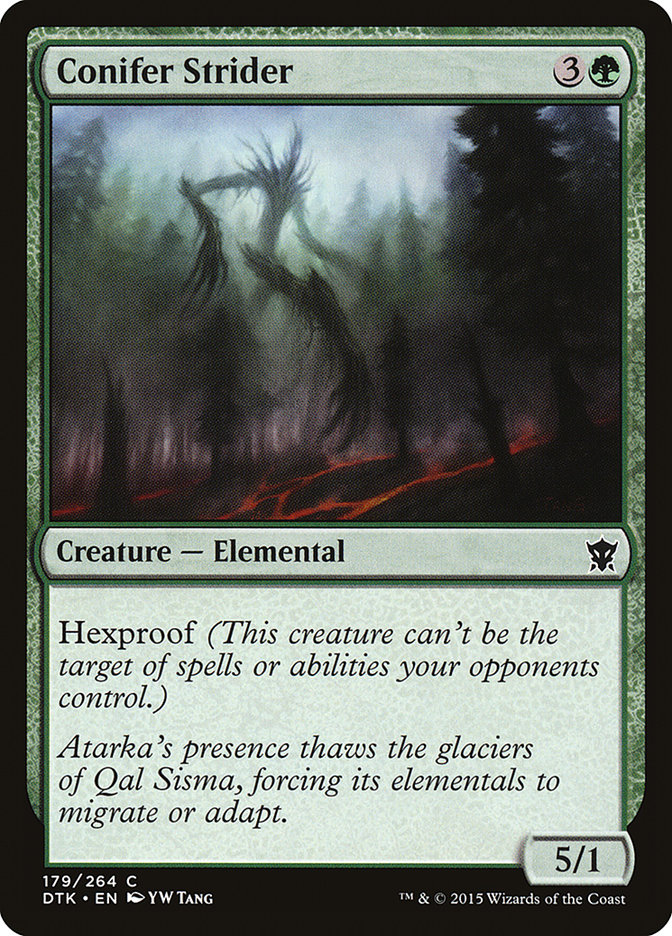
Bassar Tower Archer and Cloudform are the other “good” cheap options, and Heliod’s Pilgrim can go look for good auras if we have any. Sadly, without any good options for giving our creatures lifelink, I’m not sure we can really go this route. Maybe it is enough to put Aqueous Form on a Conifer Strider and ride that to victory, but I feel like we might lose a lot of races.
It’s sweet that Heliod’s Pilgrim can find Pacifism, so at least we’ve got that going for us. Still, not too much to report on that front yet. Instead, let’s take a look at red aggro!
Creatures (19)
- 4 Foundry Street Denizen
- 4 Firedrinker Satyr
- 1 Goblin Rabblemaster
- 4 Monastery Swiftspear
- 3 Mardu Scout
- 3 Zurgo Bellstriker
Lands (9)
Spells (32)

There are a lot of possibilities for red aggro, and finding the balance between cheap creatures and burn is a tricky one. This build attempts to maximize Atarka’s Command.
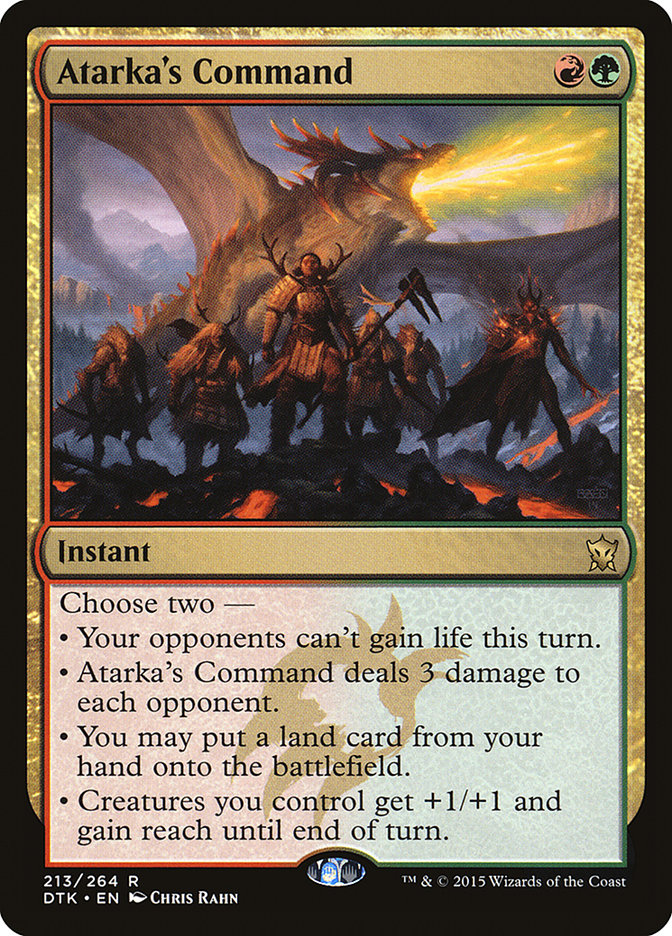
More than just a Skullcrack reprint (which is nice in this world of Siege Rhino), Atarka’s Command giving your team +1/+1 is actually a really potent option, particularly when combined with doing three to their face. That is often going to add up to six or more damage for just two mana. This card is very good.
Putting a land into play from our hand? OK, we’re probably not using that mode much in this deck, however there will be decks that do. Sometimes you just dome them for three on their end step, then surprise them by untapped and casting Xenagos, the Reveler the turn they played a Satyr Wayfinder.
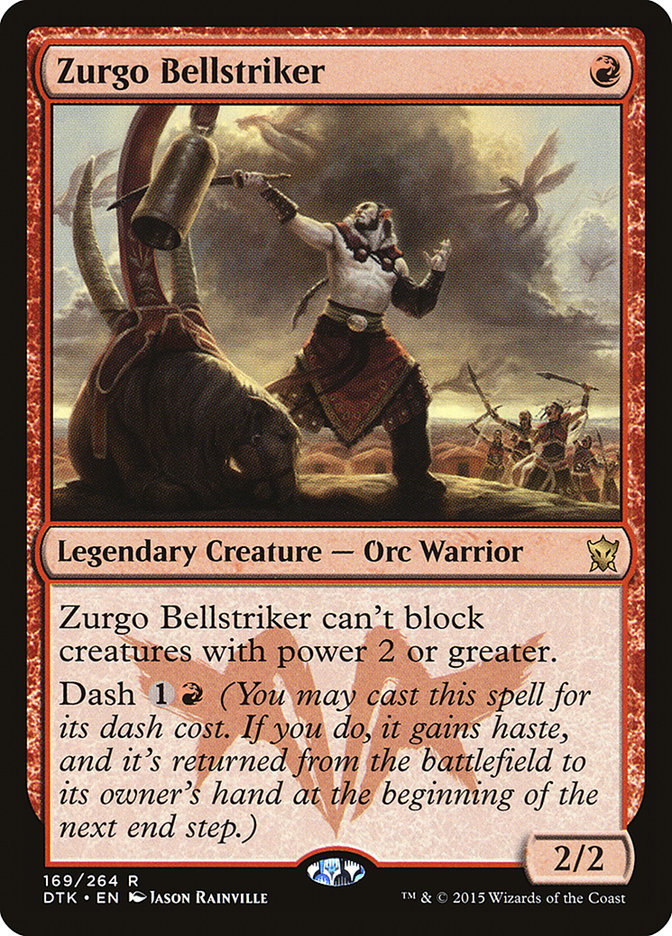
This card is fine and will definitely be played in lots of red aggro decks, but I bet it turns out to be worse than people expect. The two drawbacks are actually going to be meaningful (legend rule and difficulty blocking). Dash is super sweet with Foundry Street Denizen, however. I’ll give you that much.
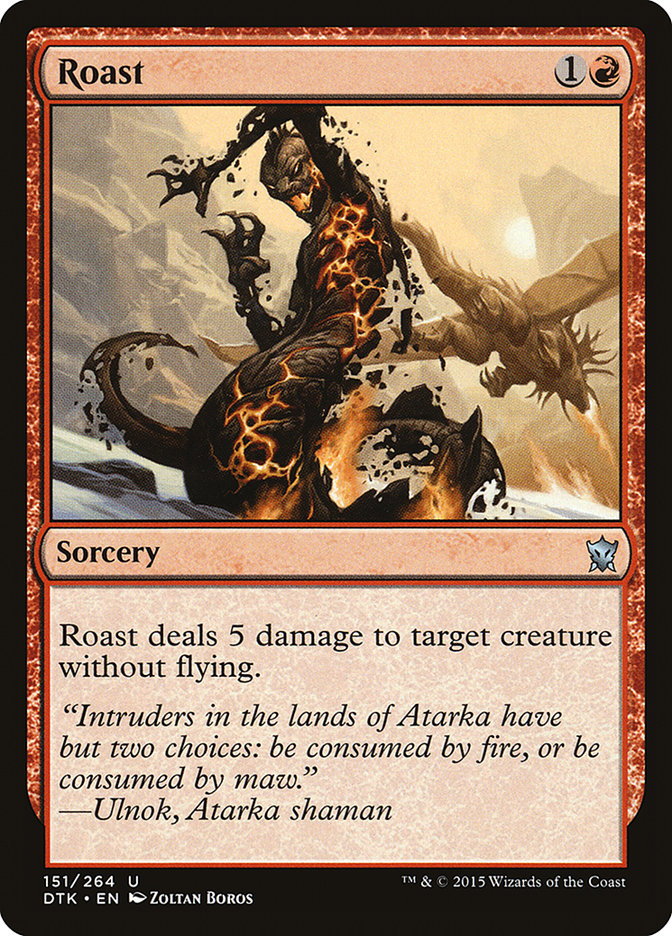
While there’s been a recent backlash against this card, this is exactly what a hyper-aggressive red deck is in the market for. Its printing is going to have an impact on how attractive cards like Siege Rhino and Tasigur are.

While I have not placed any in the above list, I expect more balanced lists to be very in the market for Ire Shaman for all the reasons detailed earlier today. This is just a good card.
Let’s take a look at a very different kind of burn deck…
Creatures (4)
Lands (16)
Spells (40)

This deck is obviously built to abuse Living Lore.
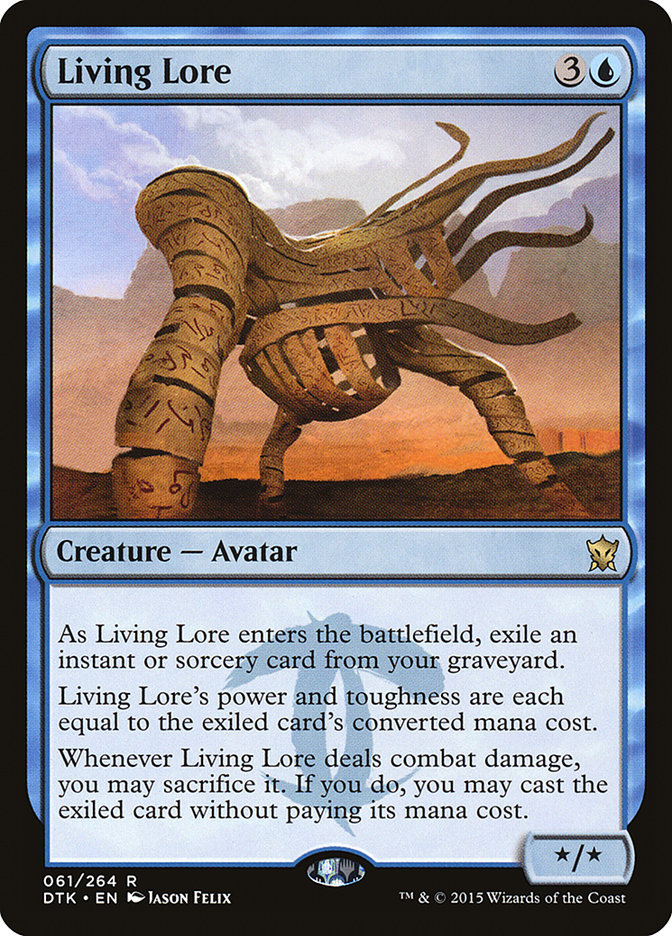
The catch to Living Lore is typically that you need to actually get an expensive spell into your graveyard to take advantage of it, and stuff like Tormented Voice can help. However, delve cards like Dig Through Time and Treasure Cruise aren’t hard to get into the graveyard by turn four or five without any major handicaps. Now Living Lore is an 8/8 for four, with the option to cash it in for that big spell if we are so inclined when it hits anything – not just our opponent, one of their creatures will suffice. Everyone thinks it needs to get through unblocked in order to get that spell, but those words everyone keeps reading, “to an opponent,” just aren’t written on the card.
This isn’t as combo-rific as we could be, but I actually think Living Lore doesn’t need to get so crazy to be good. Hell, we could actually just sideboard it in any Dig Through Time/Treasure Cruise deck without targets game one. Then, when our opponent has less removal, sometimes we’ll have 8/8s for four.
Once we are playing a ton of big blue delve cards, it starts looking a lot more attractive to play Riddle of Lightning, and we haven’t even gotten into the possibility of Temporal Trespass!
Beyond the fancy-pants maneuvers, we’re just trying to play a passable Counter-Burn game, and in fact, we can transform into a legit counter-burn deck after sideboarding if needed.
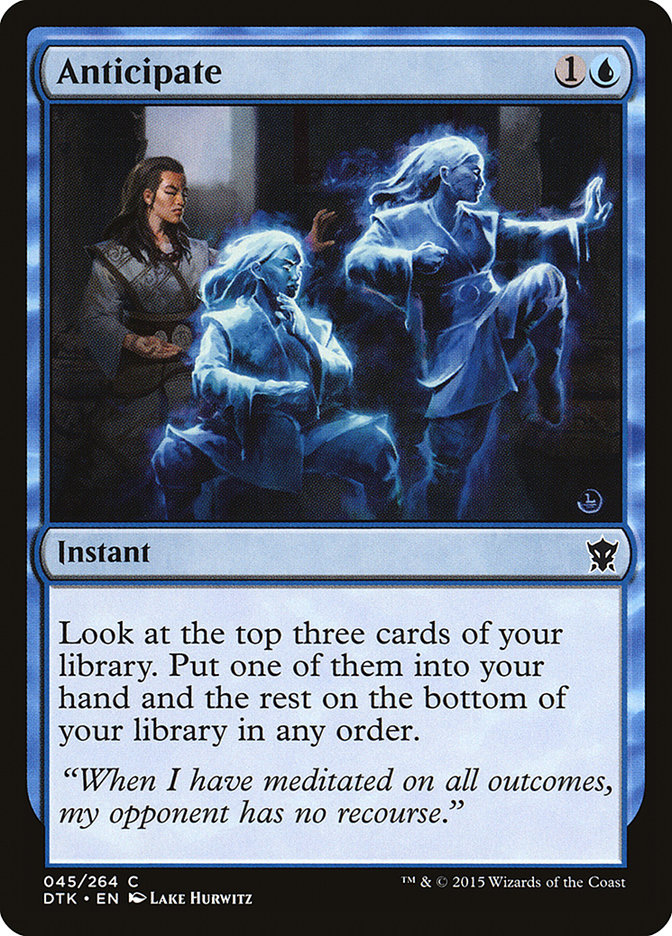
This card rules. You better ask somebody.
Creatures (5)
Planeswalkers (2)
Lands (17)
Spells (36)

While I don’t condone playing Turbo-Fog decks, particularly if you want the people you play with to not quit Magic, some people love them and they can be metagame spoilers if the field gets too predictable.
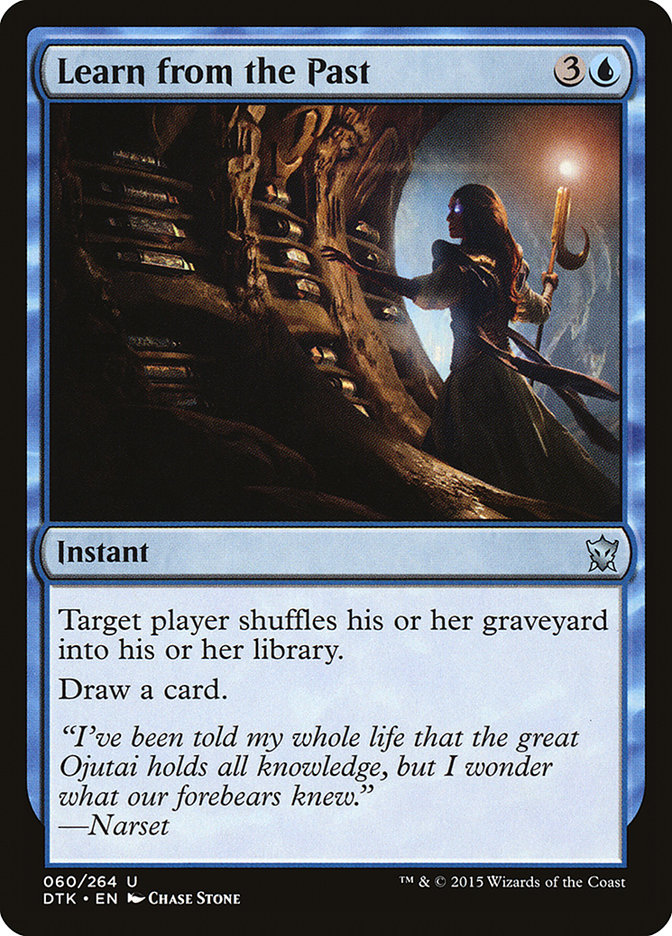
Learn from the Past can be a sideboard tool for control decks that want late-game inevitability, however, it is much weaker than Elixir of Immortality was. Yes, it draws a card, which is nice, but the five life Elixir gained was actually a pretty big deal. Besides, the Elixir shuffling itself back meant you only needed one copy in your deck to go “infinite.” Being down a card wasn’t even that big a deal when you had access to things like Sphinx’s Revelation.
Learn from the Past is slow, doesn’t loop by itself, and is much easier to counter. That said, cantripping is sweet, and it can actually be used on opponents that have too many graveyard shenanigans going on. Of course, the part of Learn from the Past I am most excited about is exiling a bunch of cards I don’t want to my delve cards, then casting Learn from the Past to make my library sweet.
That’s cool and all, but can we get at least one normal control deck?
How about Sultai?
Creatures (15)
- 2 Sylvan Caryatid
- 4 Courser of Kruphix
- 4 Satyr Wayfinder
- 1 Silumgar, the Drifting Death
- 1 Tasigur, the Golden Fang
- 1 Dragonlord Silumgar
- 2 Sidisi, Undead Vizier
Planeswalkers (2)
Lands (23)
Spells (20)

OK, so maybe this isn’t the most normal build of Sultai, but we can also build the U/B Control with Satyr Wayfinder and Sultai Charm version later. Sidisi, Undead Vizier could be a major game-changer.
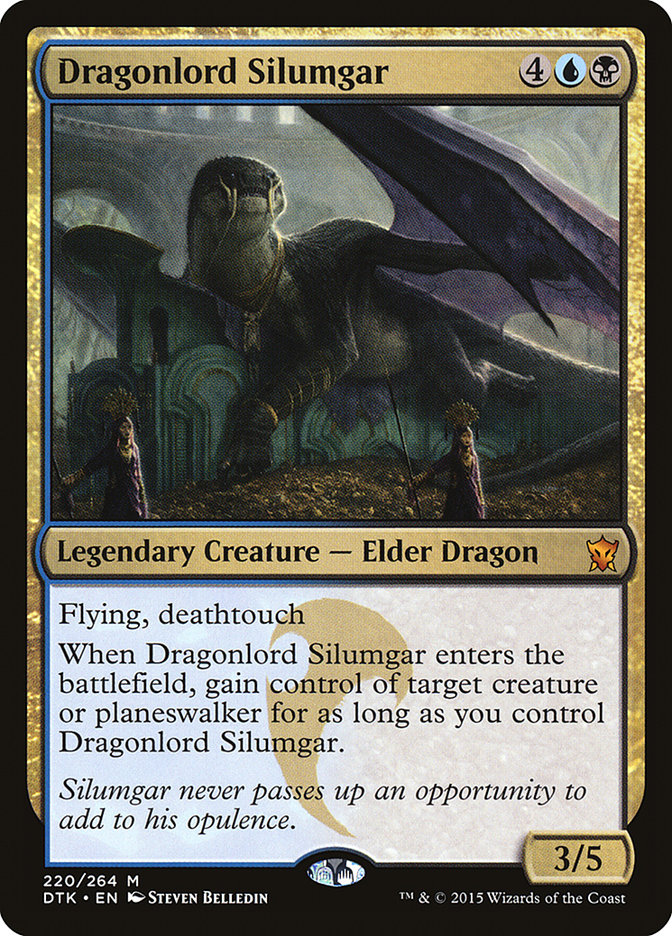
Besides, we need to find a home for Dragonlonrd Silumgar. He’s just too good to drift.
What makes Silumgar so good? A 3/5 flying deathtouch body that can’t be Ultimate Priced, Elspethed, or Stoked with Flames is attractive, but the ability is absurd. Stealing a creature is often game-winning if they can’t find a removal spell fast, which you could counter – or set it up beforehand, because Thoughtseize is great at clearing a path. Stolen creatures also make great food to feed Sidisi!
Best of all, if you steal a planeswalker, you can use it that turn, which includes potentially hijacking an ultimate!
While this list is more of a control deck, we could also just build a Sultai Reanimator deck. Sidisi is a great addition, and Silumgar is totally reasonable if we have stuff like Thoughtseize to help protect it. I particularly like how good Sidisi is with Whip of Erebos. Remember, if you Whip Sidisi, you can sacrifice her to herself, and since she was going to die anyway, that’s just pure value!
Actually, before we call it a day, a lot of people have asked about a real Temur Control deck built around Sarkhan Unbroken that isn’t just a Temur Monsters deck. Let’s give it a try:
Creatures (15)
- 4 Courser of Kruphix
- 4 Satyr Wayfinder
- 1 Keranos, God of Storms
- 3 Savage Knuckleblade
- 3 Dragonlord Atarka
Planeswalkers (3)
Lands (17)
Spells (26)

Roast helps shore up this color combination’s usual troubles with fatties, though I am nervous about our vulnerabilities to fliers, particularly big ones like Stormbreath Dragon.
Dragonlord Atarka is a nice finisher, and one of the most compelling parts of the deck. People are going to use their removal on plenty of our cards and aren’t always going to be able to deal with the 8/8 flier.
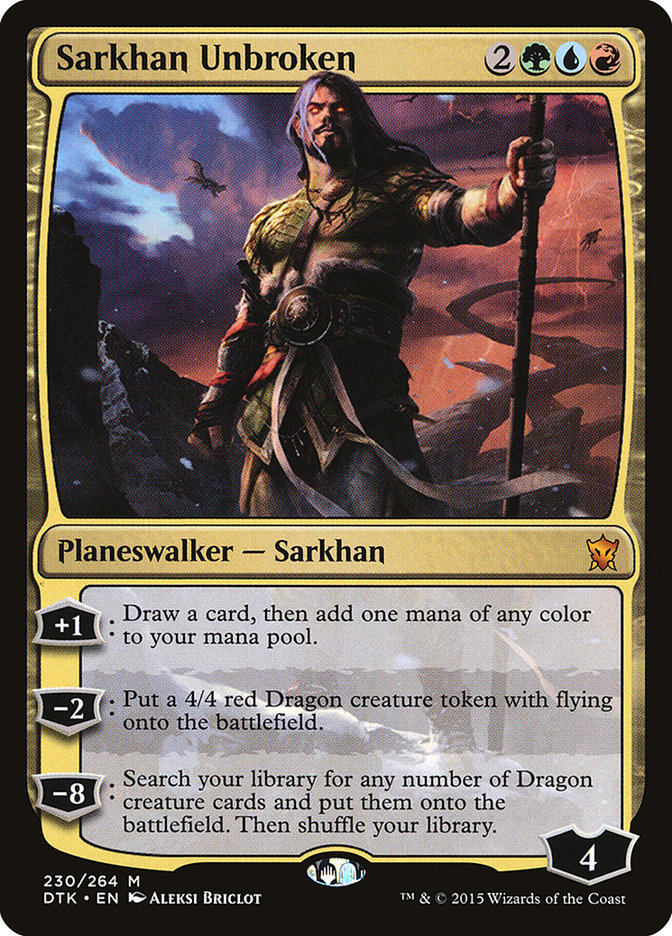
Sarkhan is a great card, albeit in an awkward color combination for it, since they have so many five-drops already and can’t really protect him like other colors could. That said, the ability to come down and make a 4/4 flier outright is huge, since now we have both a big flier to deal with and a planeswalker that can draw a card every turn.
Sarkhan’s card draw ability is also nice as a mana ability, ramping us straight into Dragonlord Atarka. I also just like being able to drop Sarkhan and use it for mana that turn. Magma Spray is perfect for this (chosen over Wild Slash because of Flamewake Phoenix, Ashcloud Phoenix, and to a lesser degree Bloodsoaked Champion). We can also drop Sarkhan when we have six mana, then use our remaining land and the Sakhan mana to Dig Through Time, Roast, or cast a blocker.
Sarkhan’s ultimate is actually pretty threatening. Here we can go get three Atarka’s, deal fifteen damage however we want and still have an 8/8. If we wanted to try harder, we could play some haste Dragon like Stormbreath or Kolaghan, however, we’re probably winning the vast majority of games where we ultimate Sarkhan even with as meager of a selection as is found here, so maybe we don’t need to get all clever.
Okay everyone, after a marathon week, I’m out, however, I will be back Monday with lessons learned from the first major event with Dragons of Tarkir, this weekend’s Season One Invitational in Richmond, Virginia. Any predictions on what cards will Top Eight the event? I’ve got a box of Girl Scout cookies to whomever is the closest with their guesses (getting one point for every right answer and losing one point for every wrong answer).
See you then!
(And check out Next Level Deckbuilding! Available now! /end shameless plug)

